Tutankhamun's tomb - traditional version. On this day the sarcophagus of Pharaoh Tutankhamun was found - Good luck and freedom to your Self
7 years ago I wrote about the faked tomb of Tutankhamun, but since then many have appeared interesting material, which was not included in the work. This article has been completely revised and practically written from scratch.How it was
One of the first to express doubts about the authenticity of the famous tomb was Konstantin Smirnov, who published the article “Will it be necessary to close the opening of the tomb of Tutankhamun?” in the journal “Technology of Youth?” (No. 4, April 1998). This article is available on the Internet, there is also a “scan” of it in PDF format. Dedicated to the same topic. This work will mainly focus on those facts that were not noted earlier or were not sufficiently disclosed.
Let us take a critical look at the available information about the history of this find and its further research. Let's take as a basis a section of the book by V. Batsalev and A. Varakin ("Secrets of Archeology. The Joy and Curse of Great Discoveries").
By the beginning of the First World War, almost the entire Valley of the Kings had been dug up far and wide, but Howard Carter, driven by an inexplicable desire to find the tomb of Tutankhamun (T) at all costs, persuaded Lord Carnarvon to sponsor new excavations, despite the assurances of famous archaeologists T. Davis and G. Maspero about the futility of such attempts.
“The sight of the Valley of the Kings made a depressing impression on Lord Carnarvon. The bottom of the pit was littered with gigantic piles of rubble and debris and gaped with black gaps of opened and robbed graves carved into the foothills of the rocks. Where to start work? Is it really possible to stir up all this rubble?..
But Carter knew where to start. He drew three lines along the plan of the pit, connecting the points of the three finds, and thus designated the triangle of searches. It turned out to be not very large and was located between three graves - Seti II, Mernepta and Ramses VI. The archaeologist turned out to be so accurate that the first blow of the pickaxe landed just above the place where the first step of the stairs leading to the tomb of Tutankhamun was located! But Howard Carter learned about this only after six long years - or rather, six archaeological seasons, during which the rubble was cleared."
Carter explained the miraculous coincidence as follows:
"At the risk of being accused of being prescient in hindsight, I nevertheless feel obliged to state that we firmly hoped to find a very specific tomb, namely that of the Pharaoh Tutankhamun."
Thus, Carter, poking his finger into the first pile of rubble he came across, found what he was looking for - practically a needle in a haystack. This is the first unique feature of the GT, which will subsequently become countless. Carter understood that this could not be, but his explanation was nothing more than demagoguery. It must be borne in mind that nothing was known about Tutankhamun before Carter. There is no pharaoh with this name in any royal list, i.e. the ancient Egyptians did not consider it necessary to preserve the memory of his reign.
The opening of the tomb, however, was delayed under all sorts of pretexts:
“For the first time in the history of excavations, Howard Carter was faced with the possibility of discovering an intact royal tomb. The temptation was great to immediately open the sealed second door, but the archaeologist acted according to his scientific duty: he announced that he would begin to remove objects from the tomb only after all measures had been taken to preserve them! The preparatory work lasted two months."
As a result, the opening of a small tomb lasted for 6 years - a unique case in world practice.
Simultaneously with the excavations, Railway directly to the GT, and in Cairo they began to add a separate wing to the Egyptian Museum to store the new exhibition. A very valuable foresight, especially considering that the volume of exhibits is still unknown.
“Finally, Carter cleared the Front Room and was ready to unwall the entrance to the Golden Chamber. Of all those who wished to be present at this event, only the Times correspondent was allowed inside.”
Carter had an agreement with The Times for exclusive coverage of the excavation, so the exploration of the tomb was melodramatically depicted step by step, although without reporters, Carter and Carnarvon examined it in one go. Meanwhile, the GT study continued to drag on:
“Carter pulled back the bolt and opened these doors, so that we could see inside a large outer ark, which reached 12 feet in length and 11 in width, another, inner ark with the same double doors, with the seals still intact. Only later did we find out , that there were four gilded arks, inserted one into the other, like in a set of Chinese carved boxes, and only the last, fourth, contained a sarcophagus, but we were able to see it only a year later.
Here's how Howard Carter himself talked about it:
At that moment we lost all desire to open these seals, for we suddenly felt that we were invading forbidden possessions; this oppressive feeling was further intensified by the linen coverings that fell from the inner ark. It seemed to us that the ghost of the deceased pharaoh had appeared before us, and we must bow before him."
Carter is not original here either - he was stalling for time, slyly making excuses for “lost desire” and “oppressive feeling.” The exploration of the tomb was once again postponed.
Alan Gardiner's take on the significance of Howard Carter's discovery:
“This discovery added a little to our knowledge about this historical period. The tomb disappointed philologists, because it did not contain[new - author] written evidence. We know nothing about Tutankhamun himself, except that he inherited the throne after the death of his stepfather Akhenaten, that he ruled for only a few years and died at a young age."
Quite an interesting conclusion. GT is unparalleled in many respects, and Egyptologists do not find anything in it that would attract their attention. Therefore, the collection of objects from the GT is practically not studied in subsequent years, and the entire historical background accompanying Tutankhamun and the circumstances of his burial are entirely invented by Carter himself. If we separate the factual material associated with GT from Carter’s myth-making, we will get a continuous set of suspicious coincidences and absurdities. For example, Egyptologists know that 80% of GT artifacts have nothing to do with Tutankhamun, including one of the sarcophagi, which by all indications was intended for a woman.
British archaeologist Nicholas Reeves, one of the few who became interested in the contents of the GT, writes:
"We have found evidence that the inscriptions on sarcophagus cartouches and many other objects have changed. On the outer sarcophagus of Tutankhamun, for example, a face is painted very similar to the image of Akhenaten on his huge statue at Karnak; and the middle coffin of the sarcophagus is decorated with designs typical of a female burial.
...I looked inside [Tutankhamun's mask] and couldn't believe what I saw there! On the inside of the mask there was a thin seam, as if the image of the face was soldered to the headdress of the mask, and such a technique was extremely rare...”
Reeves is amazed by the unique soldering, but hundreds of kilograms of gold in the tomb of an unknown young pharaoh are no less unique fact! Recently it turned out by chance that a beard was also soldered to the mask, which Ancient Egypt traditionally secured with pins:
Place where the beard is soldered to the mask.
Soldering can be found in other places:
Soldered seams on the inner sarcophagus, made of gold 2.5-3 cm thick.
And again, the unique technology for making the mask and sarcophagus of Tutankhamun has not received a proper explanation! Let's take a closer look at other unprecedented features of the GT.
Pharaoh Tutankhamun had a unique female attribute of the mother goddess
If we pay attention to the headdresses of Tutankhamun’s masks, we will find two protomes on them - a cobra and a vulture:
The vulture is the totem of the goddess Mut (Nekhbet), who personified the mother goddess. One example of its use as a headdress:
A fragment of the painting in the tomb of Nefertari: on the left is the goddess Hathor (mother of the god Horus), on the right is Queen Nefertari with offerings to the goddess Hathor.
The cobra (uraeus) on the headdress of the pharaohs symbolizes belonging to the royal House of sun-like gods, which was considered the rulers of Ancient Egypt, therefore the uraeus does not carry gender characteristics - it was worn on headdresses by both kings and queens:
Uraeus on the headdresses of the queen of the XVIII dynasty and the kings of the XXI dynasty.
However, the queens had a richer choice of symbolism, thus expressing the statuses of royalty and motherhood:
Head of a statue of Queen Tiye, wife of Amenhotep III, XVIII dynasty.
One of the excellent illustrations of the difference in royal symbolism is a sketch made by French artists in Thebes during Napoleon's Egyptian campaign. It depicts the queen mother Ahmose-Nefertari on the left, and her son Amenhotep I on the right:
The headdress of Ahmose-Nefertari includes the mother goddess Mut-Nekhbet in the form of a vulture covering the queen's head, on which stands a modius, which again depicts Mut-Nekhbet with two uraei. The headdress of Amenhotep I is more laconic: a khepresh crown with a uraeus as a solar symbol.
The only pharaoh who had a female symbol on his head in the form of a vulture is Tutankhamun:
Bust from the tomb of Tutankhamun.
Tutankhamun's tomb has a unique layout
In the book "Ancient Egyptian Masters" V.S. Bogoslovsky described the order of construction of the tombs of the pharaohs:
“The carefully studied plans and measurements of the royal tombs that have reached us show that before the work began, the following were carefully thought out and fixed in the plan:
1) the overall size of the tomb as a whole, the dimensions of the rooms and the corridors connecting them;
2) the purpose of individual rooms and corridors, their name and, in accordance with this, the shape of the premises;
3) subjects of images and, consequently, their compositions.
Corridors: “First Divine Passage”, “Second Divine Passage” (option “God’s Passage of the Sun”), Third Divine Passage (with niches called “sanctuary containing the gods of the East” and “sanctuary containing the gods of the West”), "God's fourth passage" (at the end there are two niches of gatekeepers). The last corridor led to the burial chamber.
Halls: the first hall is the “waiting hall”, the second hall is the “chariot hall” (a variant of the “hall of oppressing enemies, in which there are 4 columns”), the third hall is the “house of gold” (funeral “room in which they rest”).
Small transitions: “God’s transition, which is in the place of ushebti” (in the same place “Place of rest of the gods,” i.e., figurines of deities); on the sides of this passage there are “treasuries”; "God's second passage, which is behind the house of gold."
Elements of architectural decoration: “lintel”, “door frame”, “portal”, “thickness of the portal”, “wooden door”.
Thus, the plan of the tomb was drawn up in advance - without any haste, with which Howard Carter explains all the absurdities of GT (H. Carter, “The Tomb of Tutankhamun”):
"...many signs indicate great haste in the construction and interior design of it[Tutatnkhamon - author] tombs."
Moreover, construction of the tomb began immediately at the beginning of the pharaoh’s reign, and not after his death, including sudden death. Tutankhamun, according to various estimates, ruled from 9 to 10 years (1332-1323 BC), during which time, according to G. Carter, he managed to build a miniature tomb:
Plan of Tutankhamun's tomb. Its length is 30.79 m, area - 109.83 m², volume - 277.01 m³
To see how imperfect it is, let's compare it with the tombs of the rulers of Ancient Egypt of the same era, taking into account Carter's words:
"...however, in the era of the XVIII dynasty, they began to decorate only the funeral room, covering the walls with texts that were considered especially necessary for the deceased[M. - i.e. exactly like in the tomb of Tutankhamun] ".
Thutmose III(1479-1425 BC). The total length of the tomb is 76.11 m, area - 310.92 m², volume - 792.71 m³. Not only the burial chamber, but also the rest of the rooms were painted:
Amenhotep II(1427-1400 BC) - layout like Thutmose III. The walls are painted with hieratic texts from the Book of Amduat. The total length of the tomb is 91.87 m, area - 362.85 m², volume - 852.21 m³.
The hall and adjacent rooms are richly decorated:
Thutmose IV(1400-1390 BC) - ruled as long as Tutankhamun, which did not stop him from building a tomb with a length of 105.73 meters, an area of 407.7 m² and a volume of 1062.36 m³. The layout of the tomb is similar to the tombs of its predecessors, but differs from them in innovations in decoration. Instead of muted shades and imitation of hieratic, the entrance well and the front chamber are decorated with images of the pharaoh and the deities of the underworld. The burial chamber is not decorated! Probably they were going to, but didn’t have time.
Amenhotep III(1390-1336 BC) - some of the most grandiose buildings Ancient Egypt: temples, palaces, colossi of Memnon and a grandiose tomb with a length of 126.68 meters, an area of 554.92 m² and a volume of 1485.88 m³. The tomb, including the burial chamber, is decorated with scenes from the Book of Amduat and frescoes depicting Amenhotep with the gods:
Fragment of the painting of the tomb of Amenhotep III.
Hey(1327-1323 BC) - despite the fact that he ruled only 4 years after Tutankhamun, he managed to build himself a large tomb, 60.16 meters long, 212.22 m² in area and 618.26 m³ in volume. Belzoni was discovered in 1816, but for some reason was not cleared until 1972. A peculiarity of the texts of the tomb is that they continue to venerate the god Aten, but it is most famous for the fact that the painting of the burial chamber is surprisingly similar to GT. Moreover, time has not been kind to the frescoes of the Ey tomb, and supposedly the older ones in the GT do not have mechanical damage:
Intact frescoes in the GT - on the left, on the right - crumbling frescoes of the Ey tomb.
The unique state of preservation of GT paintings has no analogues.
Horemheb(1323-1295 BC). The tomb of Horemheb is striking in its size: total length - 127.88 m, area - 472.61 m², volume - 1328.17 m³. The frescoes of the tomb are considered one of the pearls of ancient Egyptian art:
Frescoes in the well (at the beginning) of Horemheb's tomb.
However, the burial chamber is not finished and was left as is at the time of the pharaoh's death:
Horemheb's burial chamber.
Examples of tombs of pharaohs who lived before and after Tutankhamun demonstrate that GT in no way fits into ancient Egyptian funerary standards - neither in size nor in layout. The obligatory corridors were not only not cut through, they were not even planned: instead of the sacred underground world, where the deceased pharaoh was supposed to go, ordinary warehouses were built. In addition, the decoration of the tombs contradicts Carter's statement about the decoration of only the burial room - apparently, it was generally painted last, because in a number of cases, the Book of the Dead (Amduat) was left partially or completely without decoration and texts.
The tomb of Tutankhamun is affected by unique fungi, found nowhere else
The first to talk about mysterious fungi, of course, was Howard Carter himself (H. Carter, “The Tomb of Tutankhamun”):
“The surface of the walls is covered with small brown mushroom-shaped growths, the germs of which may have been carried along with the plaster or paint. A breeding ground for them was created by the prevailing dampness, released from the plaster after the room was sealed.”
Fungi have been lamented for almost a hundred years: in 2009, Zahi Hawass again complained to the media:
“Every time I look at the tomb of the pharaoh, I am surprised by these stains, the origin of which no scientist can explain.”
A fragment of a fresco from the tomb of Tutankhamun, where the stains are clearly visible.
In the same year, the GT was closed for restoration, the main goal of which was to clarify the nature of the origin of the stains. The contractor was the Paul Getty Conservation Institute. After about 2 years:
Questions were forwarded to microbiologist Ralph Mitchell of Harvard University, who finally sorted out the stains. His team's researchers took samples of plaster and paint from the tomb's walls and analyzed them microbiologically and chemically. It turned out that melanin, metabolic products of fungi and some bacteria give the brown color to the spots, but no living bacteria were found in the samples. According to scientists, they are all dead or, scientifically speaking, inactive.
Moreover, after studying photographs of the walls taken 89 years ago, the researchers saw that the spots had not changed in size since then. And although scientists were unable to identify ancient microorganisms, they were convinced that the spots did not change over time and appeared shortly after the burial of the famous boy pharaoh.
These stains indicate, says Mitchell, that the burial was carried out in great haste.
It was not possible to find living organisms in the spots, therefore the spots did not grow, and there were no fungal growths that Carter talked about. But how did the spots themselves appear?
Until recently, high-resolution color photographs of the GT frescoes were absent or inaccessible, and photographs from the Howard Carter catalog were unsuitable for research purposes. But the beautifully executed photo album “Treasures of the Pharaohs” (Delia Pemberton), released in 2008, resolved this problem - its high-quality photographs allow for a detailed study of the GT frescoes. Their enlarged fragments revealed characteristic defects: the black paint had spread in many places:
Fragments of frescoes from the tomb of Tutankhamun. In the profile on the left, black paint floated along the contour of the face and around the eyes.
This happened due to the wrong selection of colors. The Egyptians, who had been perfecting the technology for making frescoes for thousands of years, did not allow such mistakes - stains occur in a single place, in the GT. And Howard Carter, talking about fungal growths that in reality did not exist, thus let slip: “the germs were brought in with the paint.” This paint is known - it is an extract of the chaga mushroom, which is a thick dark brown liquid. Carter hoped that the extract contained fungal germs, but they were not there, which became known only after a study by the Paul Getty Institute. The main component of the extract, which gives it its characteristic color, is melanin. It was needed to hide the defects of black paint spreading on the GT paintings - chaga extract was simply splashed on the walls. And this technique really worked - scientists still justify all the absurdities encountered in GT, including melanin stains on the walls, by the extraordinary haste invented by Carter. In addition, the stains create the appearance of aging, without which the frescoes would look like new.
The mummy of Tutankhamun is unique in its own way and has no analogues among the mummies of Egyptian kings
The two levels of resin in the skull mean that the mummy was embalmed twice. This, of course, answers the question about how the “mummy of Tutankhamun” appeared: it was made from another mummy of a mere mortal (not of royal origin), which was stuffed with treasures and placed in a golden sarcophagus, wearing a golden mask. The mummy's sarcophagus was then filled with embalming resin and heated to high temperatures to harden the resin, creating the appearance of aging. Howard Carter says again in his book:
“At one time, about two full buckets of fragrant liquid were poured onto the golden sarcophagus, and the same amount was poured onto the dead body lying inside.”
How can one find out about the consistency of the embalming composition, its viscosity, the number of evaporated fractions, unless he personally poured out 4 full buckets of incense?! At the same time, Carter overdid it with the heating - perhaps he was in a hurry - and burned the mummy, so in the book he had to complain about the inept Egyptians:
“The more our work progressed, the more obvious it became that both the cover and the mummy itself were in a deplorable state. They were completely charred as a result of exposure to fatty acids contained in the incense with which they were impregnated.”
View of the mummy burned by Howard Carter.
The charring of "Tutankhamun's mummy" should be added to the above list of anomalies under No. 7. Surprisingly, however, Egyptologists accepted Carter's version at face value and even subsequently developed it into the phantasmagoric theory of spontaneous combustion. They are not at all embarrassed by the uniqueness of this phenomenon:
“An amazing - almost supernatural - discovery was made by British scientists: anthropologist Dr Robert Connolly from the University of Liverpool - the same one who was the first to x-ray the mummy of Tutankhamun in 1968 - and his colleague Dr Matthew Ponting ) They studied a sample extracted from the pharaoh's body and came to the conclusion that it was the body, already in the sarcophagus, was exposed to high temperature. More than 200 degrees. ...Where did the high temperature come from in the sarcophagus? It is unlikely that it was heated on purpose. Scientists have never encountered such a practice before. Most likely, in their opinion, the “culinary” heat was generated by a chemical reaction, which included embalming substances, cloth coverings and fatty tissues of the body itself - during his lifetime the pharaoh was a very well-fed young man. ... Connolly and Ponting believe that the chemical reaction was the result of some error in embalming. But which one? There is not even any speculation on this matter. Scientists, by the way, do not rule out that the pharaoh became a victim of the so-called spontaneous human combustion (Spontaneous Human Combustion - SHC) or the devil's flame - mysterious phenomenon, the reasons for which are not entirely clear even today."(emphasis mine).
Due to tragic events, which befell the “mummy of Tutankhamun” at the behest of G. Carter, in particular by thermal carbonization, it should be noted that it cannot contain genetic material, because DNA denaturation begins at a temperature of about 70°C, and at a temperature of about 90°C the DNA completely dissociates, not to mention the temperature of over 200°C to which the sarcophagus was heated along with the mummy. Therefore, DNA tests are obviously doomed to either an erroneous result or its absence. Thus, a group of geneticists from the Swiss research center iGENEA, having studied DNA samples extracted from the mummified remains of Tutankhamun, found out that he allegedly belonged to the R1b1a2 haplogroup - the most typical for Western Europe. In fact, geneticists discovered genetic material on the mummy that was brought in by the Europeans themselves. Such contamination of samples is most typical for this kind of research: results were obtained on the genetic material of the contamination, but the DNA of the “mummy of Tutankhamun” could not be detected, therefore the currently popular stories about the genetic relationship of someone with Tutankhamun are without any basis.
The tomb of Tutankhamun has a unique satellite tomb that served as a utility room
In 2005, a group of American archaeologists led by Otto Schaden made an unexpected discovery: five meters from the GT there is a shaft going into the rock mass. In February 2006, it turned out that it leads to a room located at a depth of 10 meters, which was immediately called a tomb and assigned the number KV63, next to the GT.
Otto Schaden before passing into KV63.
However, upon first inspection, it became clear that the chamber, measuring 4 by 5 meters, was not intended for burial, but was used as a storage room and workshop. Seven sarcophagi filled with linen bandages and pillows were randomly stacked in it; vessels with natron, resins, broken ceramics, and the remains of animals and people were placed nearby. Scientists have concluded that only one mummy was embalmed in this chamber, and they directly point to the mummy in the GT:
"Given the location of the chamber, as well as the fact that its entrance was sealed with the same alluvium as the GT, it seems most likely that KV63 was the main hiding place for the embalming of Tutankhamun."(ibid.).
One of the evidence of such a connection was sarcophagus No. 1 with the image of a young woman:
Let's try to retouch the face and compare it with the conditional Tutankhamun:
On the left is the face on sarcophagus No. 1 from KV63, on the right is the “mask of Tutankhamun”.
The striking similarity did not escape the eyes of the researchers, but they immediately came up with an explanation: this is supposedly Ankhesenamun, the sister and at the same time the wife of Tutankhamun, i.e. queen mother. However, there was no explanation for the fact that on the female sarcophagus No. 1 there were no symbols of belonging to the royal House. As we now understand, this phenomenon is in close connection with the previously indicated unique features of the conventional Tutankhamun: his mummy was also not of royal origin, accordingly, the royal symbolism discovered in the GT did not refer to the pharaoh, but to the mother goddess.
Speaking about KV63 as a cache in which the remains of the embalming of Tutankhamun are preserved, scientists forget how the epic search for Tutankhamun began. Howard Carter talks about this in detail:
"Shortly before finishing his work in the Valley, he[Theodore Davis - author] discovered in a hiding place under a rock a faience cup on which the name of Tutankhamun was inscribed. Not far from this place, he came across a small shaft burial, where there was an unnamed alabaster figurine, ... as well as a broken wooden box, which contained fragments of a gold plate with the image and names of Pharaoh Tutankhamun and his wife. Based on these pieces of the gold record, Davis announced that they Tutankhamun's burial discovered. ... A little east of this grave, in the first years of his work, Davis found, in an irregularly shaped recess carved into the rock, a warehouse of sealed clay vessels with hieratic inscriptions on the shoulders. When their contents were quickly examined, it turned out that it consisted mainly of shards of crockery, strips of linen cloth and other refuse. ... There were clay seals here, some with the name of Tutankhamun, and others with impressions of the seal of the royal necropolis; fragments of clay vases with magnificent paintings; linen headbands, one of which is inscribed with the latest known date of Tutankhamun's reign; a floral wreath of the kind that mourners wore around their necks during funerals, and a host of other varied items. All these objects apparently remained from the funeral of Tutankhamun: when the funeral ceremony was over, they were collected, placed in vessels and hidden. "(emphasis mine).
From the cache found by Davis.
Thus, a cache of items left over from Tutankhamun’s funeral was found by Theodore Davis at the beginning of the 20th century, therefore KV63, discovered 100 years later, cannot be considered a repository of Tutankhamun’s funerary utensils - the mummy that Carter gave away was obviously made there for the royal mummy of Tutankhamun, making her the most famous pharaoh.
TO interesting features KV63 can be attributed to the 42-centimeter sarcophagus made of red gold (gold with a high copper content - over 50%) located there:
The arms crossed on the chest speak of the royal origin of the baby girl, who, however, was not inside. Apparently she was placed in GT and named the daughter of Tutankhamun.
(there were two in total).
Conclusion
If we count how many times the words “unique,” “unprecedented,” and “anomalous” were used in this work, we can conclude that the tomb of Tutankhamun is one complete misunderstanding. In reality, they are euphemisms to cover up Howard Carter's faked tomb in the Valley of the Kings. His only magic wand, which has a hypnotic effect on scientists - Tutankhamun was buried in a hurry - was invented by him. Carter, of course, could not act alone - he carried out his criminal enterprise under the auspices of the Egyptian authorities, who, in the wake of increased interest in Egypt in the world, had whetted their appetite. They managed to create a bright show, screaming with vulgarity, attracting millions of undemanding ordinary people with the magical shine of gold and glitter precious stones.
But sooner or later, someone must call a spade a spade, because all of the listed absurdities of GT are nothing more than evidence of the most ambitious falsification in the entire history of mankind.
The tomb of Tutankhamun, which has reached us almost in its original form after more than three thousand years, is considered one of the most important finds in archaeology. But is it possible that the discovery of the tomb is a hoax?

The official version of the discovery of the tomb of Tutankhamun, the young king of the 18th dynasty of pharaohs, looks like the events of an adventure novel written by an author of the level of Alexandre Dumas. It has everything: perseverance, work, luck, and as a result of all this - big money and worldwide fame.
In search of a dream
Howard Carter, the eighth child in the family of Samuel and Martha Carter, grew up in great poverty - he was not even able to finish school. True, Howard was a good drawer.
The desire to work led the seventeen-year-old boy to the British Society for Archaeological Research of Egypt, which needed a good draftsman.
Arriving in Egypt, the young draftsman and part-time archaeologist plunged headlong into local life. He had a difficult character and did not get along very well with the snobs from archeology, who saw him as coming from the lower classes, but he always found a common language with the Egyptians, for whom any Englishman was a master. This ability to make friends led Carter to become seriously interested in archeology and soon even joined the service as Inspector General of the Egyptian Department of Antiquities. He quickly realized that archeology was the only way to achieve position in society, respect and ensure a comfortable life for himself. But for this it was necessary to find something very interesting and significant.
As you know, large-scale searches require funds. Carter didn't have them. And then, fortunately for him, George Herbert, Lord Carnarvon, a scion of one of the richest families in England, came to Egypt for treatment. He was desperately bored and, having nothing to do, decided to start excavations in the Valley of the Kings - a place where for 500 years, from the 16th century BC. e. to the 11th century BC e., tombs were built for the burial of the pharaohs - the kings of Ancient Egypt.
Carnarvon needed an intelligent specialist, and one of Carter’s former colleagues advised Lord Howard, who at that time was unemployed and doing odd jobs. Thus, thanks to chance, a tandem was formed that was destined to revolutionize the history of archeology and Egyptology.
Triumph or shame?
Carter and Carnarvon's treasure hunt began in 1906. And it lasted, with some interruptions, until November 1922, when they managed to stumble upon the tomb of Tutankhamun. It contained more than three and a half thousand objects of art, and the most valuable of them is considered to be the death mask of Tutankhamun, made of 11.26 kg of pure gold and many precious stones.
The amazing history of this discovery was questioned almost from the first days - after all, the Valley of the Kings by that time had been dug up far and wide, and finding what the lucky English discovered was only possible in a fantastic dream. And yet it happened!
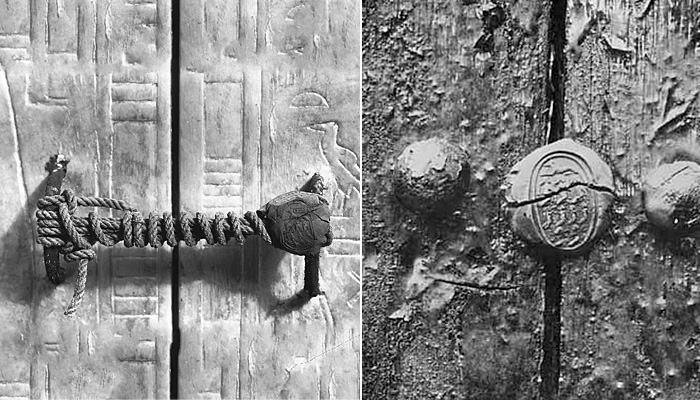
Strictly speaking, it was not difficult, since there was no trace of any outstanding discovery!
Some archaeologists, contemporaries and colleagues of Carter, even before the discovery, suggested that all the tombs existing in the Valley of the Kings were connected by underground passages. Carter knew about this too.
Therefore, having found several objects on which the name of Tutankhamun, practically unknown to scientists, was written, Howard decided to bet on it. Even before the arrival of archaeologists, local residents supplemented themselves with underground excavations - they worked, so to speak, as black archaeologists. A special place among them was occupied by the Abd el-Rasul family. They actually became the discoverers of the burials of the pharaohs back in the 19th century. Having discovered a large number of antiquities underground, an enterprising family began selling them. This continued until the police took care of them. After this, the el-Rasuls could not trade antiquities openly. It was then that Carter appeared on the horizon, who allegedly became an intermediary between tomb robbers and museums - many of the archaeologists working at that time in the Valley of the Kings knew about this. Apparently, one of the family members told Carter about the existence of the tomb, which was relatively untouched. Question: why didn’t the black archaeologists plunder the tomb themselves? Most likely, there was nothing valuable there anymore. But Carter needed a tomb that no one knew about.
Be that as it may, this happened back in 1914, eight years before the world learned about the tomb of Tutankhamun. But why was Carter silent for so long? There are several answers to this question.
Hiding your tracks
What was actually kept in the room known as the “tomb of Tutankhamun”, we will never know. But the fact that there was no one there for three thousand years before Carter is an absolute lie. Even after its supposed discovery, archaeologists paid attention to holes punched in the stone - these were traces of robbers who, presumably, took out all the most valuable things long before Carter appeared there. The main thing for Howard was that the exterior of the tomb was not badly damaged. Then he realized that this was the last and only chance to make history. The question arises: why did Carter need to take the artifacts there, because he could get rich by selling them? Here we should remember the Egyptian laws. The fact is that when archaeologists discovered some antiquities, they divided the find according to the principle: 50% to the archaeologists, 50% to the state. Moreover, if the find was legally registered, the archaeologist could choose for himself: whether to sell it to a museum or a private person, or perhaps keep it for himself. And in case of concealment, he automatically became a criminal and could not sell the valuables to anyone except private collectors.
By the time the tomb of Tutankhamun was found, Carter had already made a fortune from the illegal trade in antiquities. Now he wanted official honors, fame and a knighthood (he often spoke about this to people who knew him closely). Lord Carnarvon also dreamed of confirmation of status and good money (it was necessary to recoup the costs). So Tutankhamun was born thanks to the vanity and ambition of two English adventurers.
While the war-torn world was dividing up the earth's riches, Carter and Carnarvon were preparing an archaeological "bomb." Everything that subsequently delighted the world was taken to the half-empty tomb: a golden bier, a throne, statues, alabaster vases, unusual-looking caskets, jewelry. Carter’s people added various objects to the already completed burial, which were supposed to play the role of “the utensils of the deceased pharaoh.”
Traces of their penetration were disguised as traces of ancient robbers. Some of the loaded items were real, some were fake. For this purpose, Carter ordered them in Cairo. The golden chariots that were brought into the tomb sawn into pieces (and sawed them with a modern saw - the archaeologists themselves who examined the chariots spoke about this), the sarcophagus of Tutankhamun (traces of metalworker's hammers remained on the boards), and the mummy of the pharaoh itself - it was bought Carter from one of the black archaeologists and therefore ended up in very bad condition. And the gold death mask was made by Cairo craftsmen: when experts noticed that the jade inserts on the mask were of modern origin, museum workers said that the restorers had “tried their best.”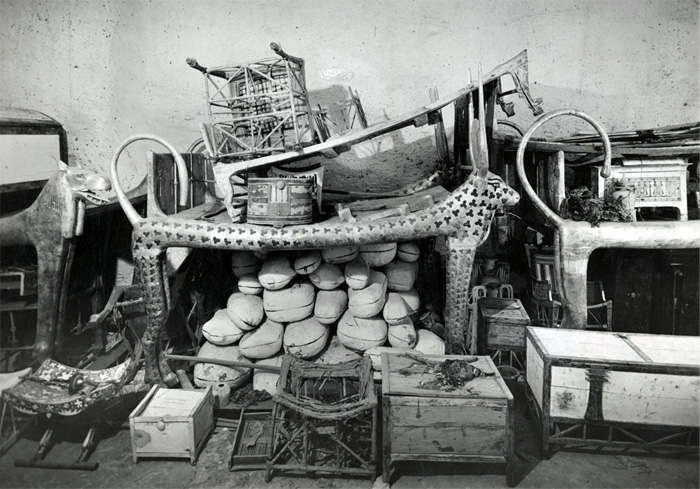
The scale of the falsification is amazing: fake antiquities were delivered to the excavation area right during the research process, for which Carter built a narrow-gauge railway. The falsifiers overdid it: the amount of “valuables” allegedly taken from Tutankhamun’s burial is so large that it could hardly fit in a room measuring only 80 square meters (this is the area of a modern three-room apartment - and is this the tomb of the great pharaoh?)
Alas, all these inconsistencies were ignored by the enthusiastic public. The world, exhausted by war, revolutions, and deaths, longed for something positive and exciting. And the false tomb discovered by a couple of “great archaeologists” suited everyone.
Thanks to this falsification, archaeologists received fame and fortune, Egypt - tourists, museums - exhibits, scientists - public interest.

As the famous archaeologist Howard Carter said: "In the present state of our knowledge, we can say with certainty only one thing: the only significant event in his life was that he died and was buried" ...
And be that as it may, but oh The opening of this unique monument to eternity, which took place on November 4, 1922, was a phenomenal success and, unlike its owner, the tomb of the pharaoh was a colossal discovery. Thanks to the items that Tutankhamun took with him into the afterlife, modern world thousands of secrets have been revealed ancient state. The scale of the things found, including utensils, examples of art, luxury items, a sarcophagus made of pure gold, potions, is striking in its scope.

But subsequently, the joy of archaeologists was overshadowed by a strange series of deaths of expedition members and their loved ones. The whole world started talking about the “curse of Pharaoh.” It is no coincidence that a clay tablet with an ominous inscription was left in the tomb of Tutankhamun: “The pitchfork of death will pierce the one who disturbs the peace of the pharaoh.”
Or maybe it was the “curse” that worked because of the falsification from which archaeologists received fame and fortune?
One way or another, the curse began to take effect... The first victim was Lord Cornarvon, who financed the expedition. This happened in April 1923 in Cairo, the cause was pneumonia. A woman, the lord's nurse, was found dead in a room at the Continental Hotel with Cornarvon. Just a few days later, in the same hotel, the life of archaeologist Arthur Mace, participating in the excavation of the tomb of the pharaoh, was interrupted.
After this, death took the lives of millionaire George Gould, who also visited the tomb, and the radiologist who worked with the mummy of Tutankhamun, Archie Reid.
The curse did not end there; within a few years, Cornarvon's half-brother, the lord's widow, American professors James Henry Brasted, Norman de Harris Davis and Sir Alan Henderson Gardiner died under mysterious circumstances. There are 22 “victims of the curse” in total.
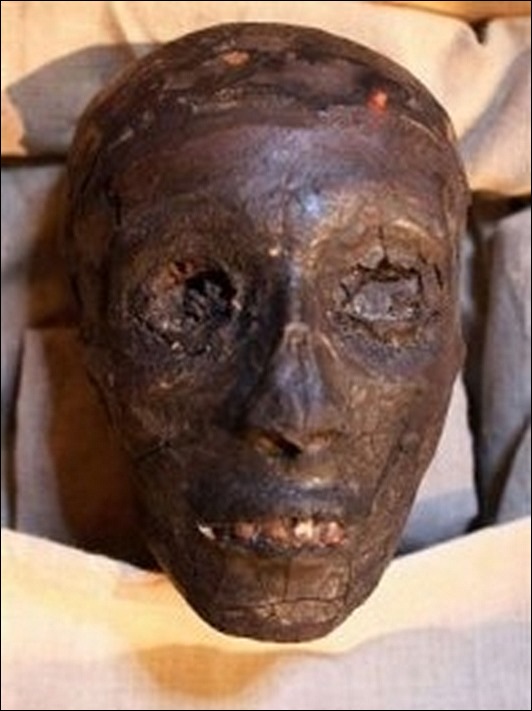
However, some scientists are suspicious of the “curse of the pharaoh”. The average life expectancy of “victims of the curse” is 74.4 years. But it is impossible to firmly say that all 22 people died of natural causes. There are too many mysteries associated with the death of the “damned”. It is also worth noting that, by a strange coincidence, Lord Cornarvon, who financed the expedition and possibly pursued selfish motives, and his relatives suffered the most.
The fact that George Cornavorn, going to the Valley of the Kings, pursued his own goals is evidenced by the fact that the lord’s grandson, Henry Herbert, found numerous caches containing works of ancient Egyptian art and jewelry in the old castle that belonged to his grandfather. Perhaps that is why the wrath of the pharaoh affected this family to a greater extent.
Also, the cause of death of expedition members and close associates could have been poisons placed in the tomb. It is known that the ancient Egyptians masterfully prepared poisons. Their pharmaceutical knowledge was legendary.
One more possible reason called fungus and other microorganisms that usually form in caves and, in particular, in tombs.
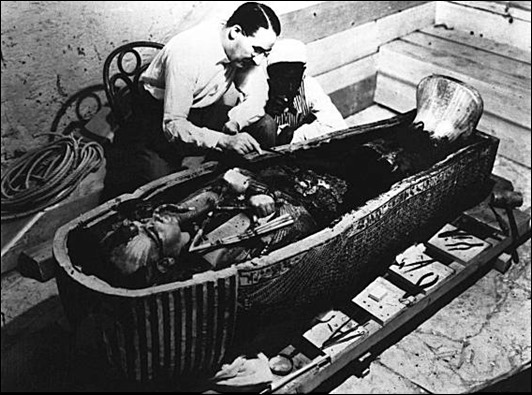
It is curious that during the visit of USSR Secretary General Nikita Khrushchev, the KGB strictly forbade the Soviet delegation from entering the tomb. The ruler of the USSR politely refused the offer of the Egyptian authorities to visit the pyramid.
Now the mysterious tomb of Tutankhamun itself risks sinking into oblivion, since the walls of the tomb are covered with stains of unknown origin. The Egyptian authorities decided to close the tomb for restoration work; the preliminary period of work is 5 years.
Perhaps, thanks to these works, humanity will reveal more than one secret of Ancient Egypt. Or will such intervention result in a new series of “victims of the Pharaoh’s curse”...?
Howard Carter. Explorer who discovered Tutankhamun's tomb in 1922.
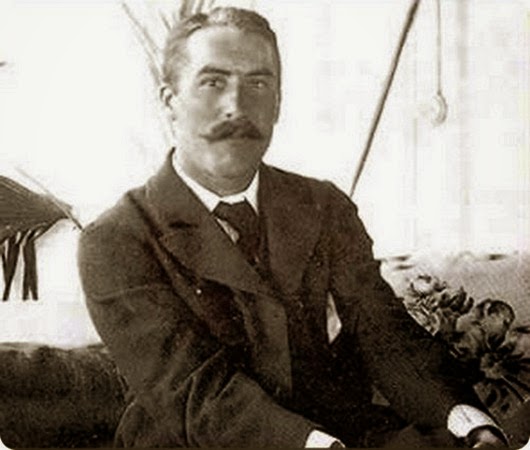
Lord Carnarvon. It was he who financed archaeological excavations. At that time, this excavation idea was considered complete madness. In 1923 he died of pneumonia.
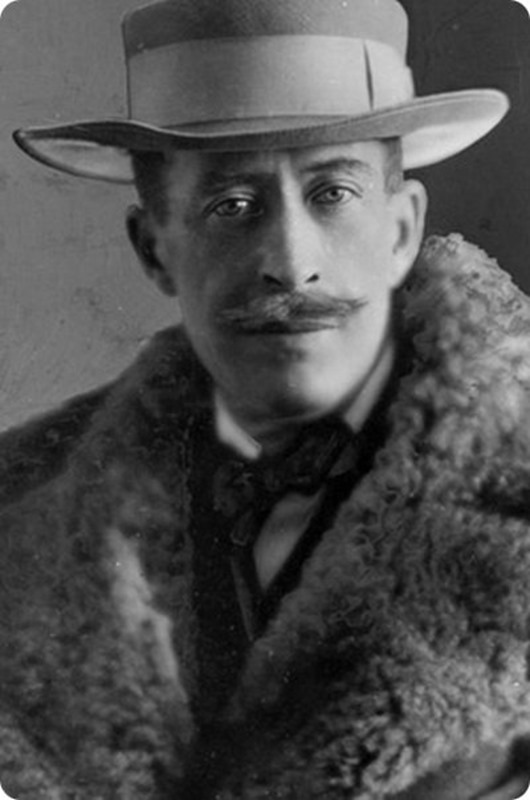
Carter opens the naos that surrounded the sarcophagus. This took 84 days.

In the treasury of the tomb.

Pristine naos seal. None of the robbers dared to open it.

Carter cleans dust from Tutankhamun's sarcophagus with a brush.
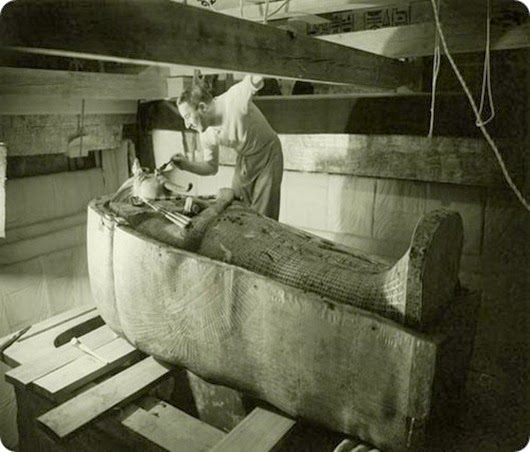
Opening of the third sarcophagus. The photo shows a golden mask that hid the pharaoh's mummy.
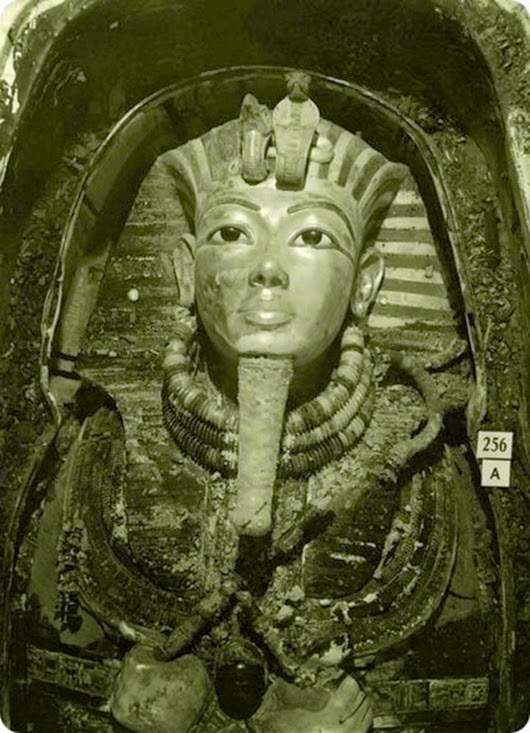
Exploration of the tomb.
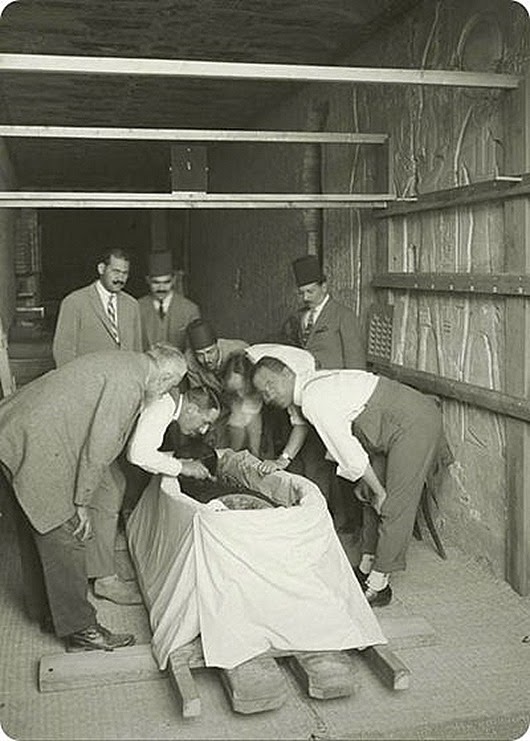
The very first photograph of Tutankhamun's sarcophagus.
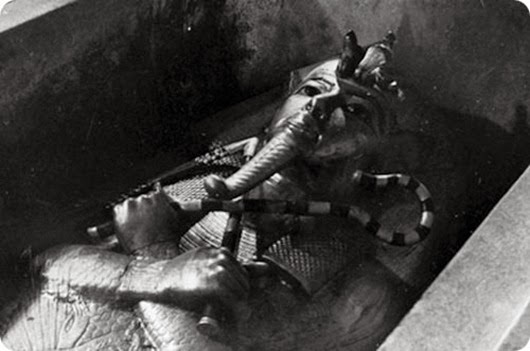
The sarcophagus of Tutankhamun was opened for the first time.

Entrance to Tutankhamun's tomb.
![]()
Wooden (second) sarcophagus of Pharaoh Tutankhamun.
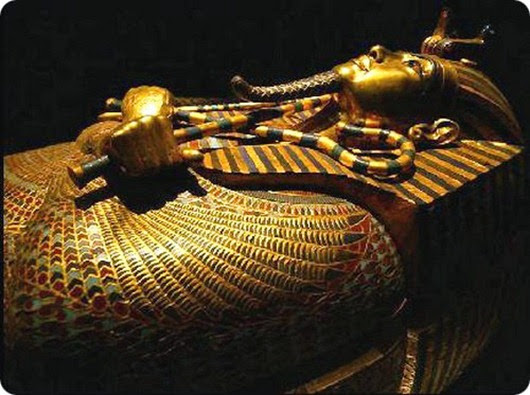
Golden (third) sarcophagus of Tutankhamun.
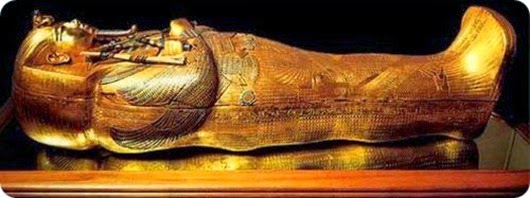
In 2007, the sarcophagus of 19-year-old Tutankhamun was returned.

Mummy of Tutankhamun.
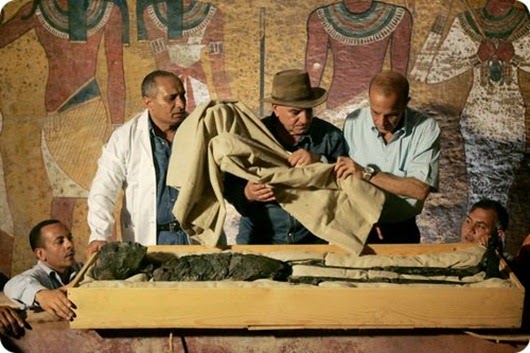
Legs of a mummified pharaoh. The tomb is under special glass to preserve a special microclimate.
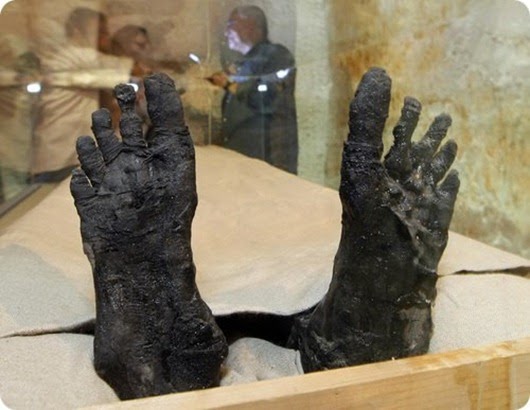
A mummified embryo that was found in the tomb of a pharaoh in 1922.
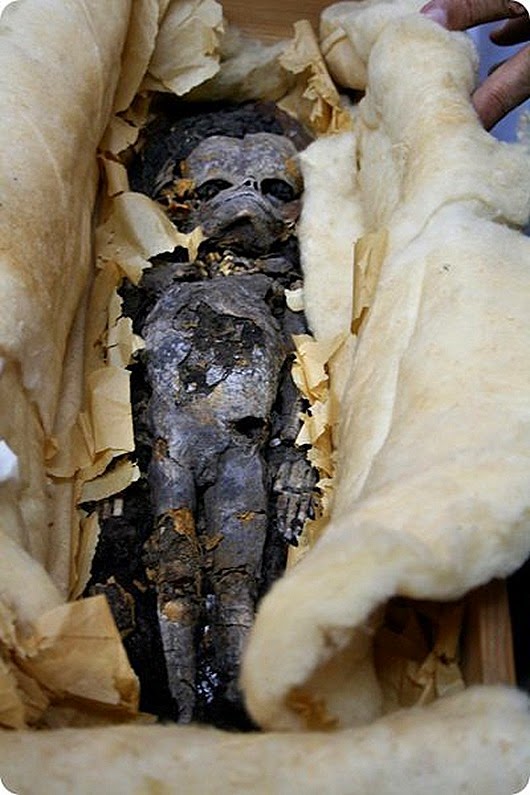
Mummy of Tutankhamun.
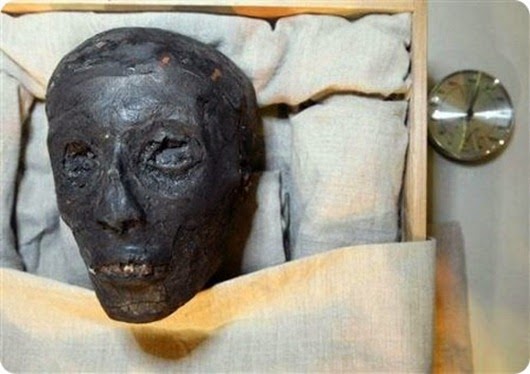
According to experts, this is what 19-year-old Tutankhamun looked like

One traveler told the story of Tutankhamun’s tomb and provided a photo report of the excursion. Photos from the 2013 exhibition in Berlin"Tutankhamun. His tomb and treasures" (German: Tutanchamun Sein Grab und die Schätze)
Despite the fact that the exhibition presents only recreated copies and there is not a single original, it is breathtaking and gives the impression that you are really in that time and have access to the most intimate and inaccessible. Amazing exhibition, great project.
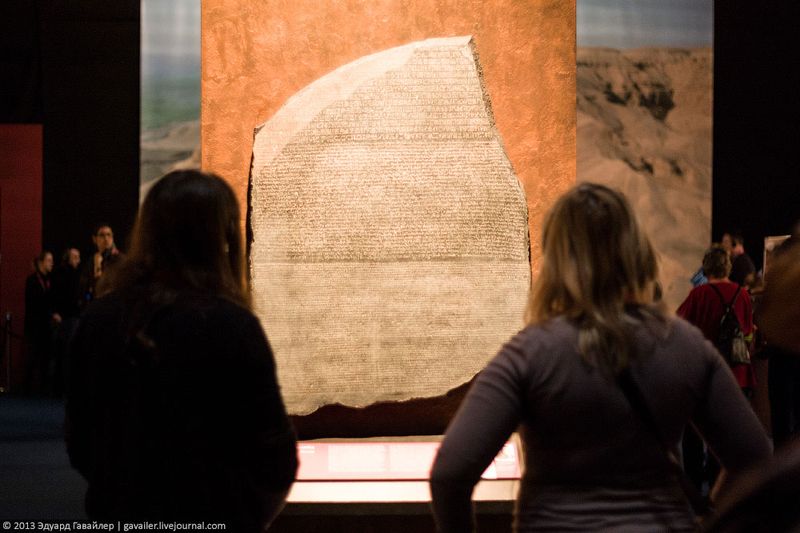
The Rosetta Stone is a slab found at the end of the 18th century in Egypt near the city of Rosetta. It contains text identical in meaning in three languages: two ancient Egyptian and Greek. It was he who served as the starting point for deciphering Egyptian hieroglyphs.
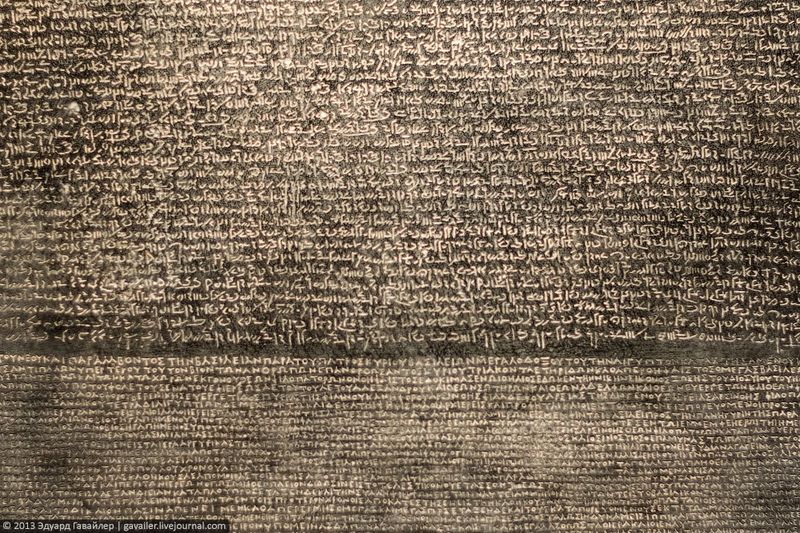
The pharaoh from the XVIII dynasty of the New Kingdom ruled for about 9 years, from approximately 1332 to 1323 BC (died at the age of 19).

Before reaching his 20th birthday, Tutankhamun died (or perhaps was killed) and was buried in a tomb in the “Valley of the Kings” near Thebes.

On November 26, 1922, English Egyptologist Howard Carter and archaeologist Lord Carnarvon became the first to descend into the tomb in more than three thousand years. All artifacts were photographed, numbered and described.
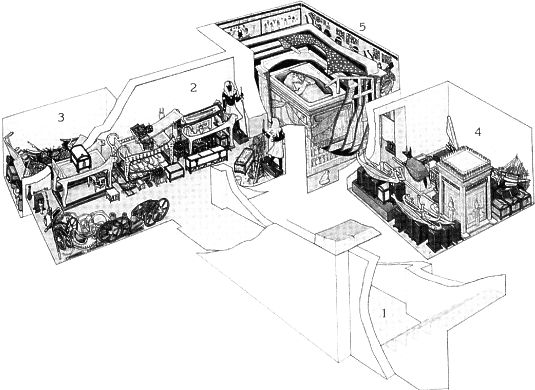
Treasures of the tomb.
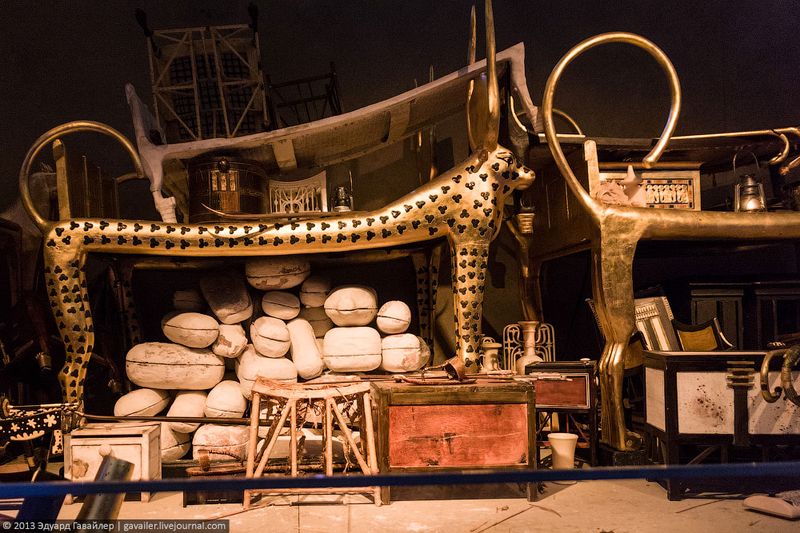

Naturally most of The exhibition is devoted to the description of the tomb of the pharaoh. His mummy was located in three sarcophagi nested inside each other. Two of them were made of gilded wood, and the third was made of pure gold. The sarcophagi themselves were closed in four gilded “cabinets”, also located inside each other.

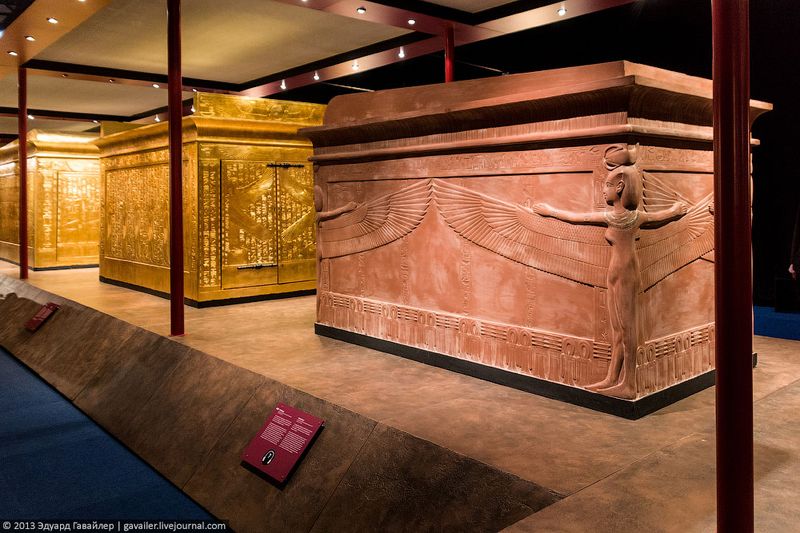
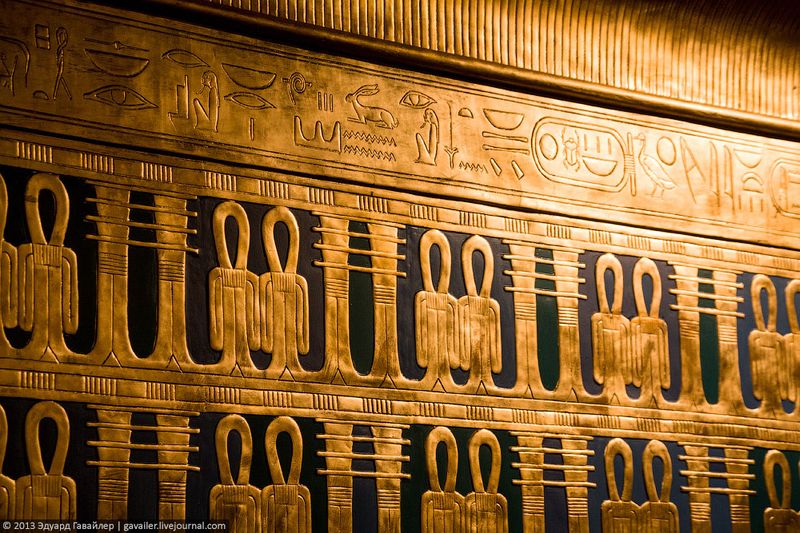
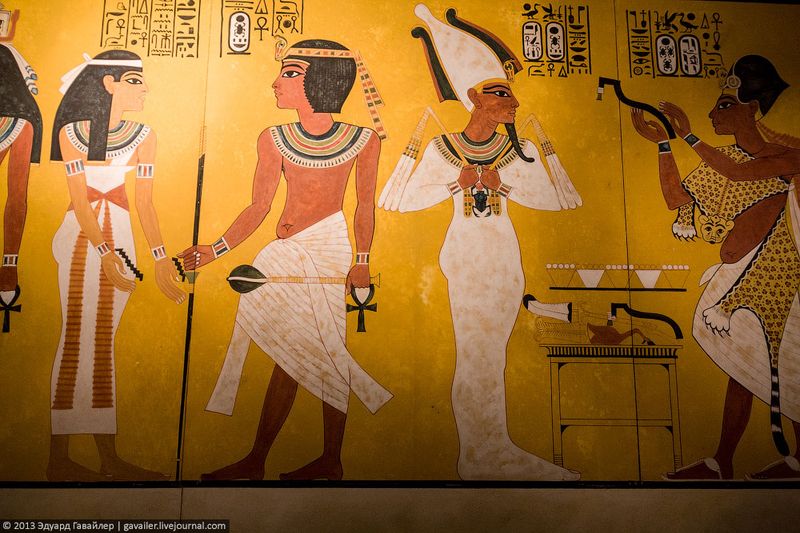
The sarcophagi themselves.

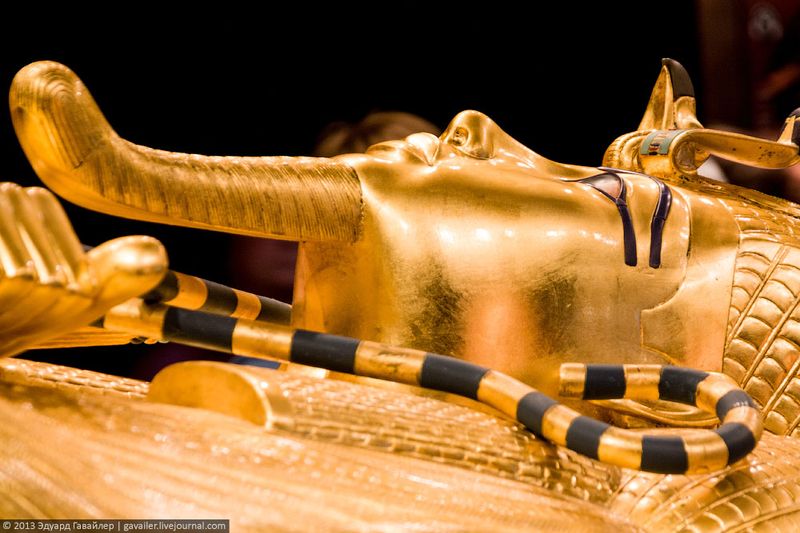
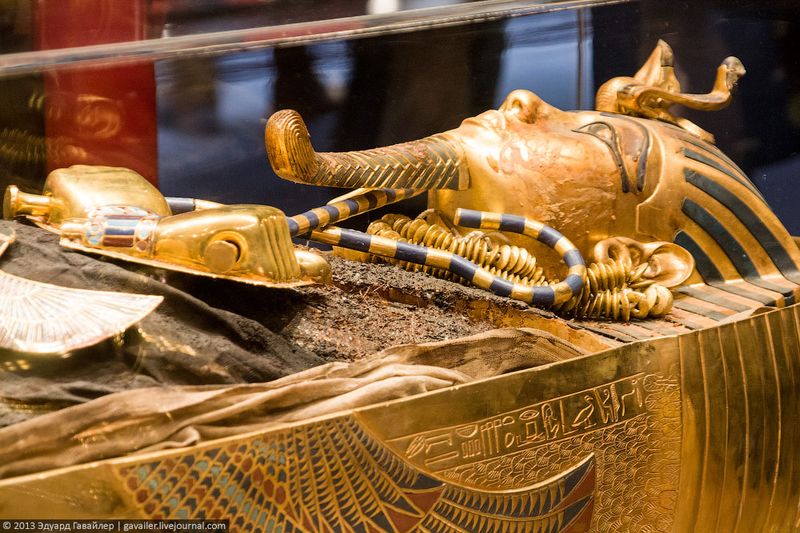
And the famous tomb mask of Tutankhamun.


Golden statue of Tutankhamun riding on the back of a black leopard.

Tutankhamun with a harpoon.

Pharaoh's throne.
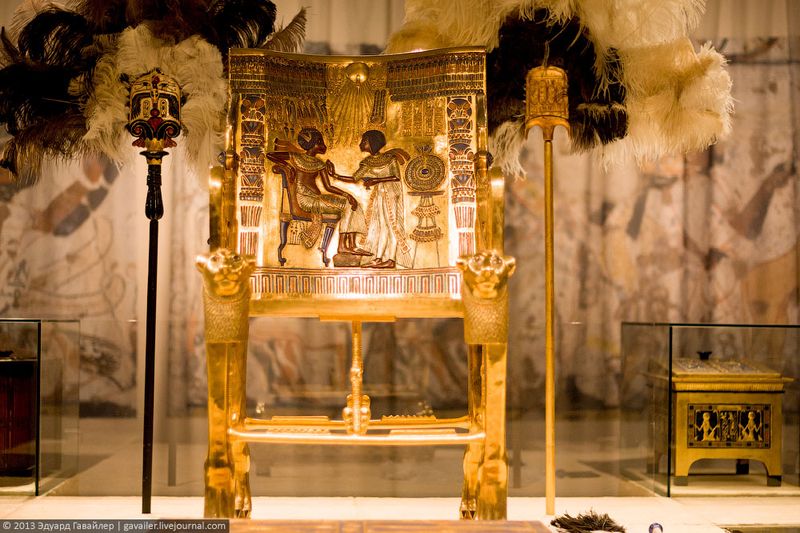
Ceremonial throne.
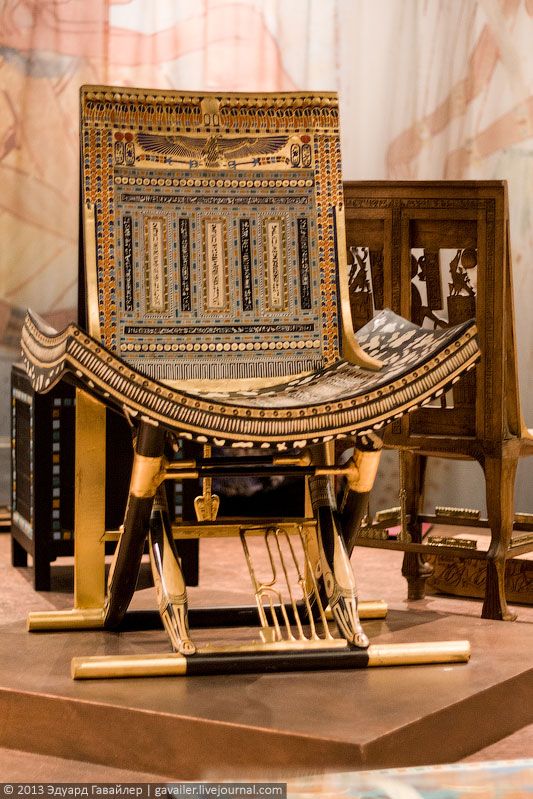
Anubis in the form of a dog

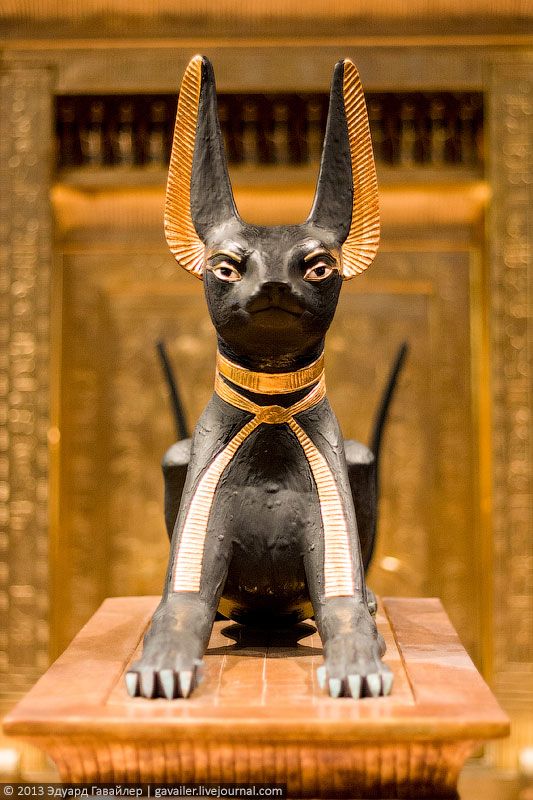
Other treasures.
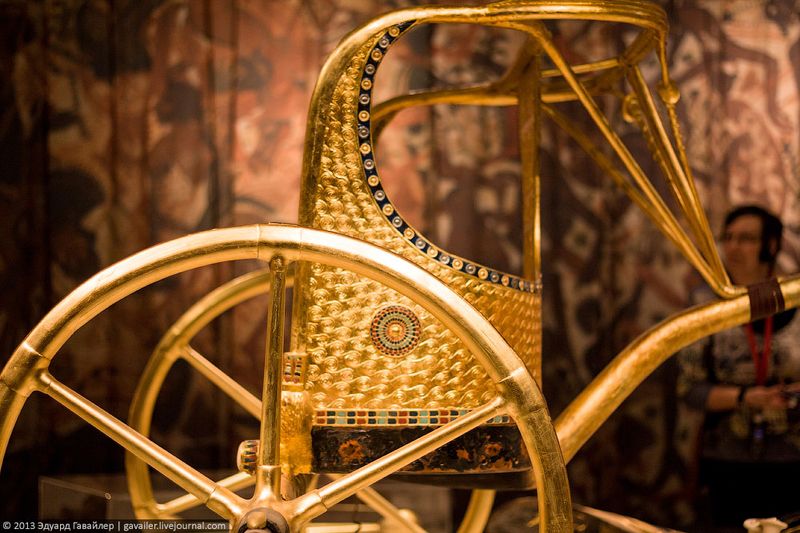
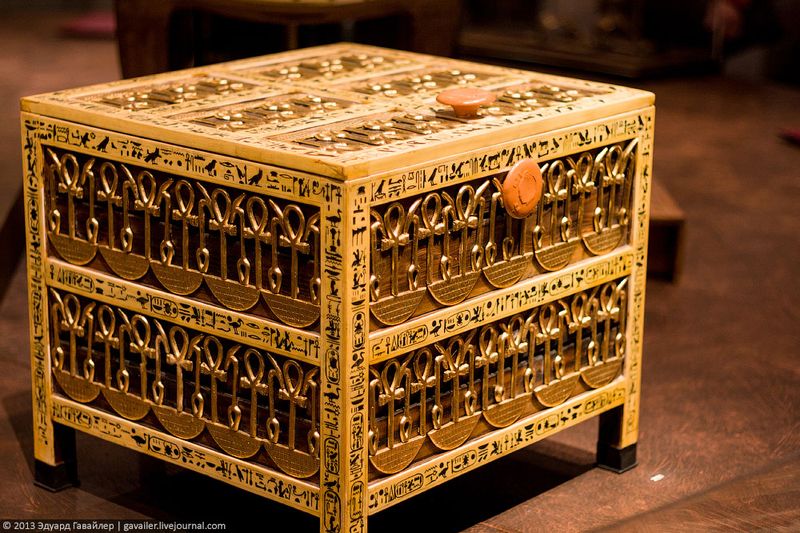

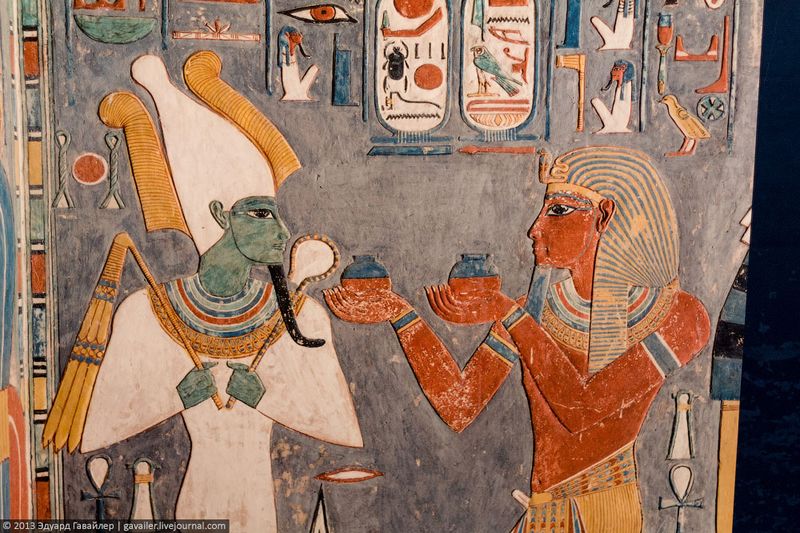
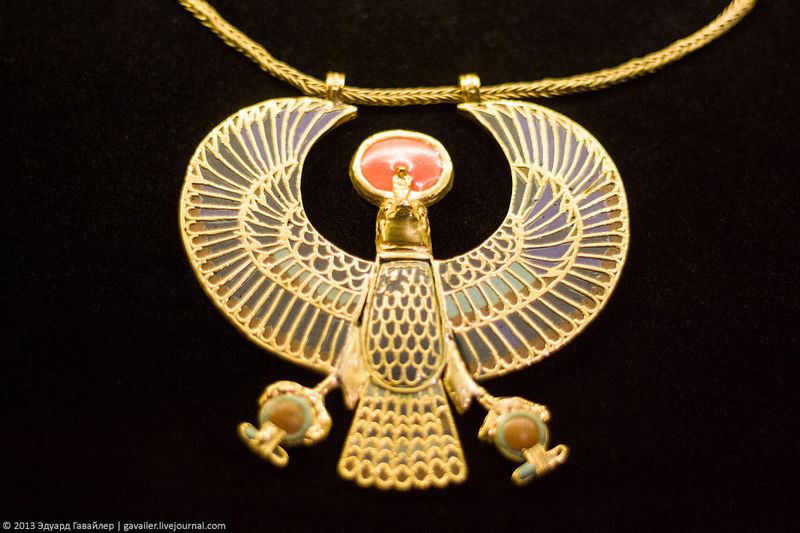
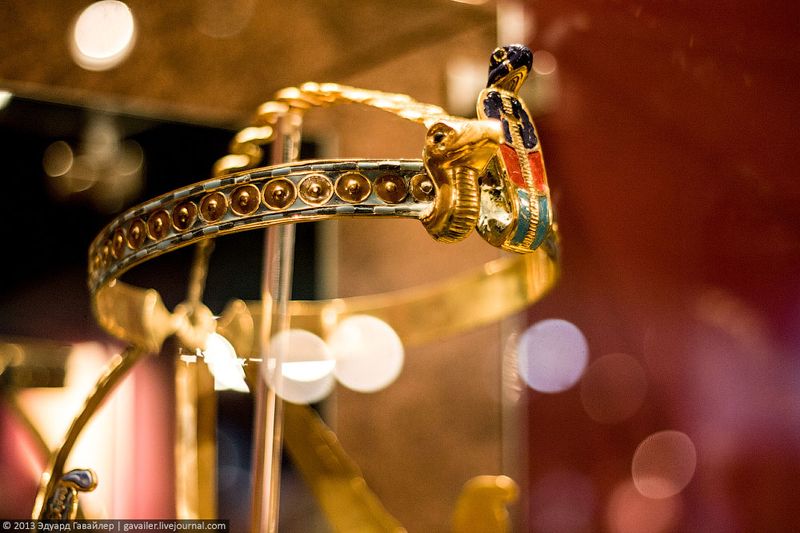
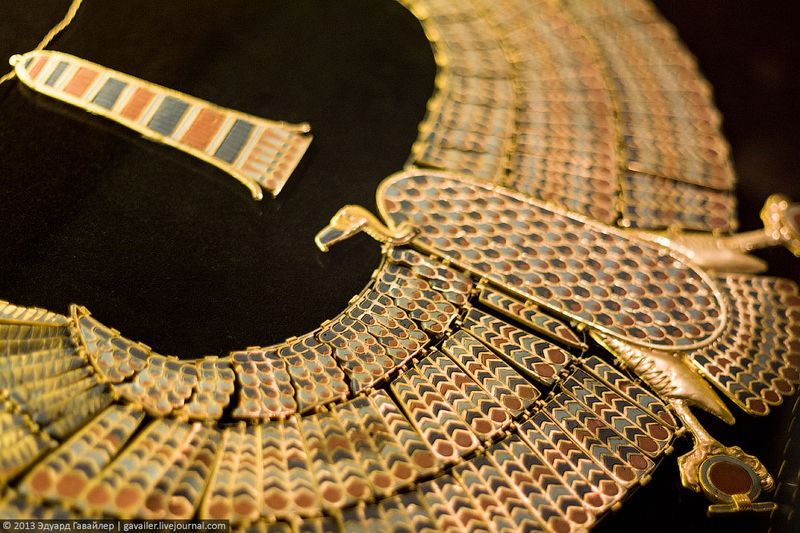
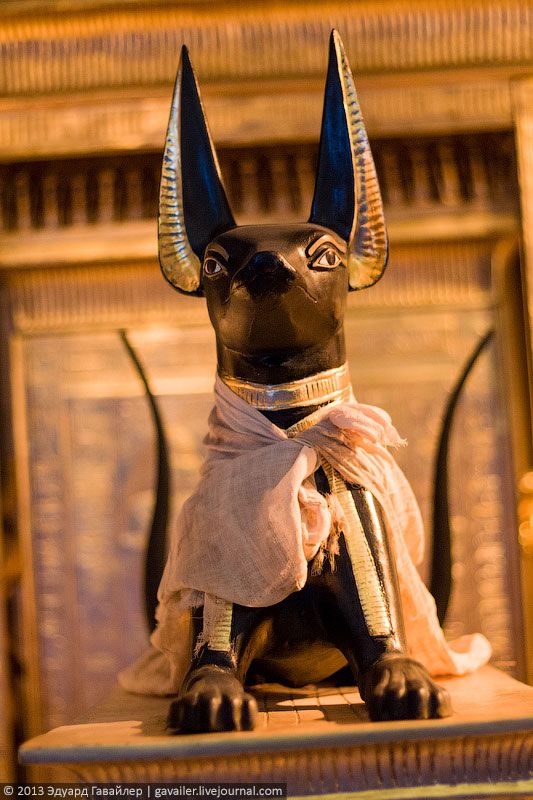
The life and death of a pharaoh
The reign of Tutankhamun falls on the period of the New Kingdom - the heyday of the ancient Egyptian state. He became the last representative of the XVIII dynasty, but ruled the country for a short time - presumably from 1332 to 1323. BC. The pharaoh died at the age of 19 or 18, and was buried in the Valley of the Kings.
It is believed that Tutankhamun was the son of Akhenaten, the famous reformer pharaoh. The Egyptian throne went to Tutankhamun when he was nine years old. As a result, during his reign, the fate of the country was controlled not so much by the ruler himself as by Akhenaten’s former comrades-in-arms.
The previous pharaoh was the author of a religious reform that shook the foundations of ancient society - the replacement of paganism with a monotheistic religion, the worship of a single sun god - Aten, and then the pharaoh himself. Tutankhamun decided to return to the old gods. The name of Akhenaten was anathematized, and his former capital Akhetaten was completely destroyed.
Disputes about the causes of Tutankhamun's death are still ongoing. Archaeological evidence shows that he was a thin and sickly young man. Yes, the proportions of his body were far from perfect: in particular, his arms were too long. That is why one of the most popular versions of the death of the pharaoh is an alleged serious illness. Some researchers, however, categorically disagree with such conclusions, insisting that the ruler of Egypt was a completely healthy person. According to some recent studies, the pharaoh died under the wheels of a cart - a wheel mark remained on the left side of his body. Be that as it may, one thing can be said with complete confidence: the pharaoh died in early youth and was buried according to all traditions.
Howard Carter's Amazing Find
The authors of the discovery, which shocked the entire scientific world, were archaeologist Howard Carter and his colleague Lord Carnarvon. The latter was not a professional archaeologist, but took on a significant part of the financing of the excavations, which began in 1914. In those years, modern archaeological devices did not yet exist, so scientists had to work in very difficult conditions - for a long time and often without results. By 1922, the lord was completely disappointed in his research, so he stopped allocating funds.
At that time, Carter was conducting excavations in the Valley of the Kings and on November 4, quite by chance, discovered the entrance to a new tomb. On the sealed door was a sign of royal blood - a symbol of the burial of Egyptian nobility. The archaeologist immediately reported his discovery to Lord Carnarvon, who was in England at that time.

©Wikimedia Commons
Here we must stop and say that even before the opening of the tomb, a seemingly unremarkable incident happened to Carter. The fact is that during the excavations Carter was accompanied by a pet - a small canary. And then one day a cobra climbed into the scientist’s home and ate the bird. The archaeologist himself did not attach any importance to this, but his servants, consisting of local residents, took this as a sign of impending trouble. Cobra is one of the symbols of the Egyptian pharaohs.
But let's return to the door Carter discovered. On November 24, Carnarvon and Carter decided to take a closer look at the strange discovery. They stuck the lamp into the hole they had made and - oh, miracle! – we saw the luxurious tomb of the pharaoh. Alas, it immediately became clear that archaeologists were not the first visitors to the tomb. Thieves came here several times for treasures, but each time for some unknown reason they were forced to flee. It seemed obvious: everything inside was turned upside down, although the pharaoh's treasures were in place. But it was not immediately possible for archaeologists to investigate the circumstances of the attempted robbery. Scientists waited a long time for permission from the authorities to carry out work in the crypt.
Work on it began on February 16, 1923. Archaeologists saw that the crypt consisted of four rooms, the main one of which was the room with the pharaoh's mummy. In the tomb, scientists found numerous gold jewelry, weapons, dishes, figurines, and symbols of royal power. Then, among the contents of the tomb, two more bodies will be discovered that belonged to the stillborn daughters of the pharaoh.
Mysterious death
The news of the archaeological sensation shook the entire scientific world. This is understandable, because we were talking about one of the most outstanding finds during the entire study of Ancient Egypt! It is unlikely that Howard Carter could then imagine that soon the tomb of Tutankhamun would glorify him even more. True, you wouldn’t wish such fame on anyone.
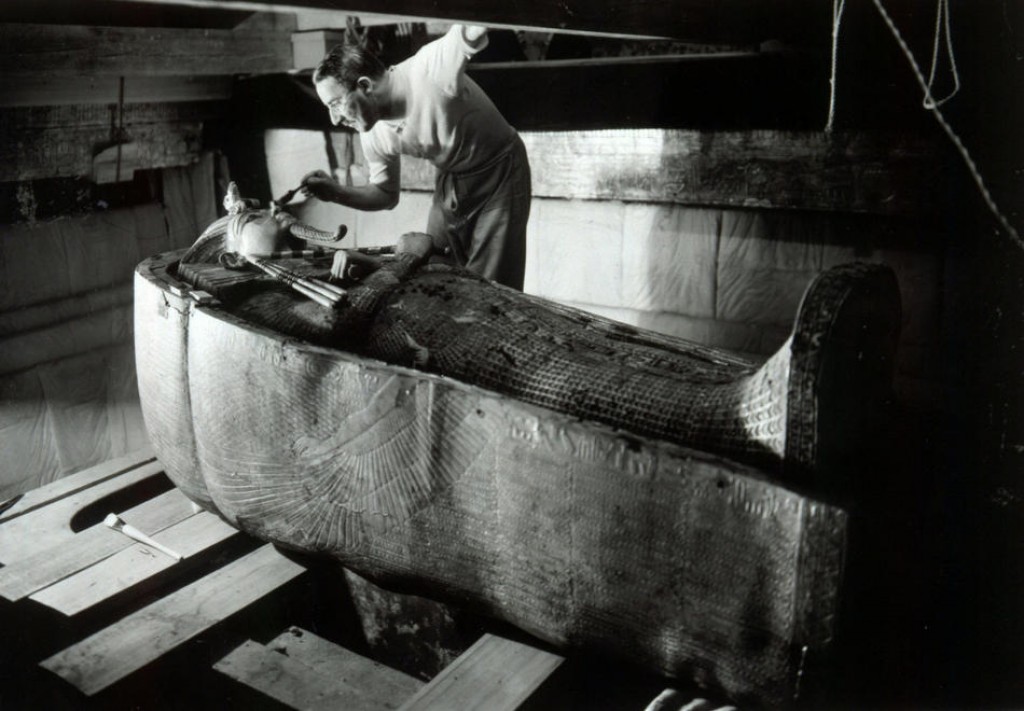
©Wikimedia Commons
In the spring of the same year, another “unremarkable event” happened to Carnarvon: he was bitten by a mosquito. A few days later, the lord cut himself at the site of the bite, and soon noticed that the small scratch did not heal for a suspiciously long time. Carnarvon's fears were realized when he developed a fever. He died soon after. Then they said that the mosquito that bit the lord was “poisonous.” The mystery of the story was added by the fact that at the moment of the lord’s death the lights suddenly went out in Cairo. The cause of the accident could not be established, but this is not all mysterious coincidences. Around the same time that Carnarvon's heart stopped, his dog, who was at his home in England at that moment, also died. Of course, all this can be explained by ordinary coincidences, inflated by the yellow press. But the death of the lord and everything that was connected with it became only the first link in a chain of ominous events.
Lord Carnarvon died on April 5, 1923, four months after visiting Tutankhamun's tomb. A few days later, Arthur Mace, one of the archaeologists who were part of Carter’s expedition, died. As far as could be judged, the cause of Mace's death was arsenic poisoning. Upon returning to England, another specialist from those excavations, radiologist Archibald Reid, died. The American financier George Gould also supervised the excavations of the tomb. He died six months later, contracting a fever.
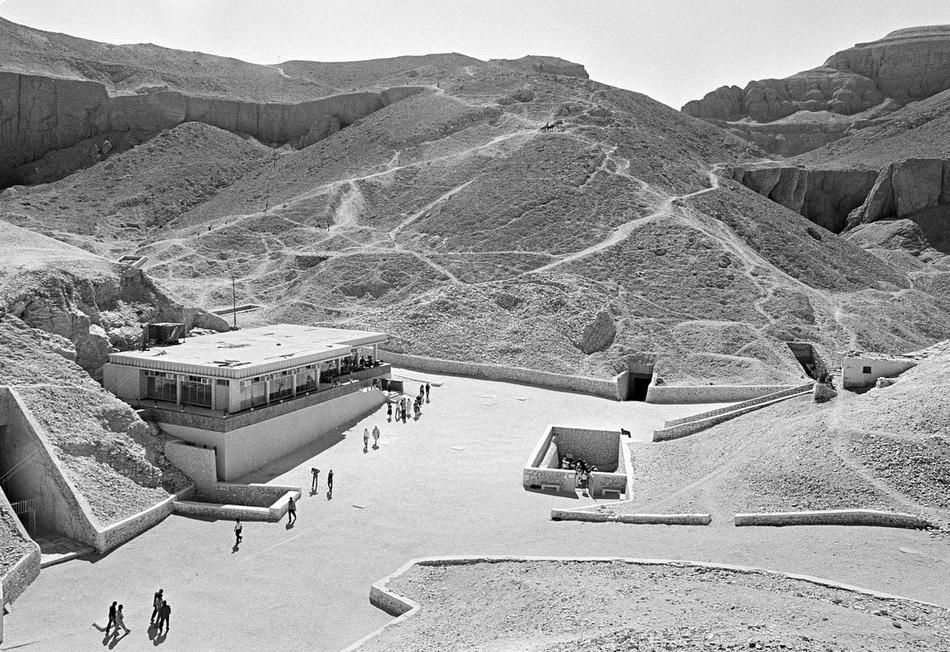
The entrance to Tutankhamun's tomb (center) lies in front of the tourist center in Egypt's Valley of the Pharaohs / ©Wikimedia Commons
Lord Carnarvon's wife died from an insect bite, and his half-brother soon committed suicide. Finally, in 1928, Howard Carter's young secretary, Richard Bartel, died. Death occurred as a result of cardiac arrest, although Barthel did not complain about his health. All these people were engaged in researching the pharaoh's mummy. In addition, Professor La Fleur, radiologist Vid and some other scientists became victims of the “curse”. In total in different time According to various sources, from 22 to 25 people died, one way or another connected with the burial of the Egyptian pharaoh. It seemed as if Tutankhamun’s revenge would overtake everyone who dared to disturb his peace...
However, proponents of the esoteric approach sometimes miss one important point: the main target of the Pharaoh's Curse, archaeologist Howard Carter, died of natural causes in 1939. At that time he was 65 years old.
In 1980, an interview was published with Richard Adamson, the last living researcher from the Carter expedition. Adamson also decisively rejected the myth of the curse of the Egyptian king. Strictly speaking, almost all deceased scientists were very old at the time of their death. Members of the Carter expedition lived an average of 74 years.

Archaeologists carry out ancient artifacts during excavations in Cairo / ©Alamy
But often not only dead scientists, but also ordinary tourists are credited to the Egyptian ruler. Cases of unexplained deaths occur even in our time.
Origins of the legend
First, let's try to figure out where the myth of the curse came from. This will sound strange, but in itself he is just a newspaper duck. Trying to ensure peace for the dead, the ancient Egyptians actually resorted to all sorts of spells and conspiracies. According to modern experts, the hieroglyphs contain some warnings, but they are often taken too literally. At the suggestion of journalists, the interpretation of some warnings sometimes turns out to be distorted beyond recognition.
Inscriptions in tombs warn the unlucky traveler against desecrating the tomb or prohibit a person of ill repute from visiting the tomb. In the case of Tutankhamun, researchers have only established that there is a spell here that protects the peace of the Egyptian king and protects him from the sands of the desert.
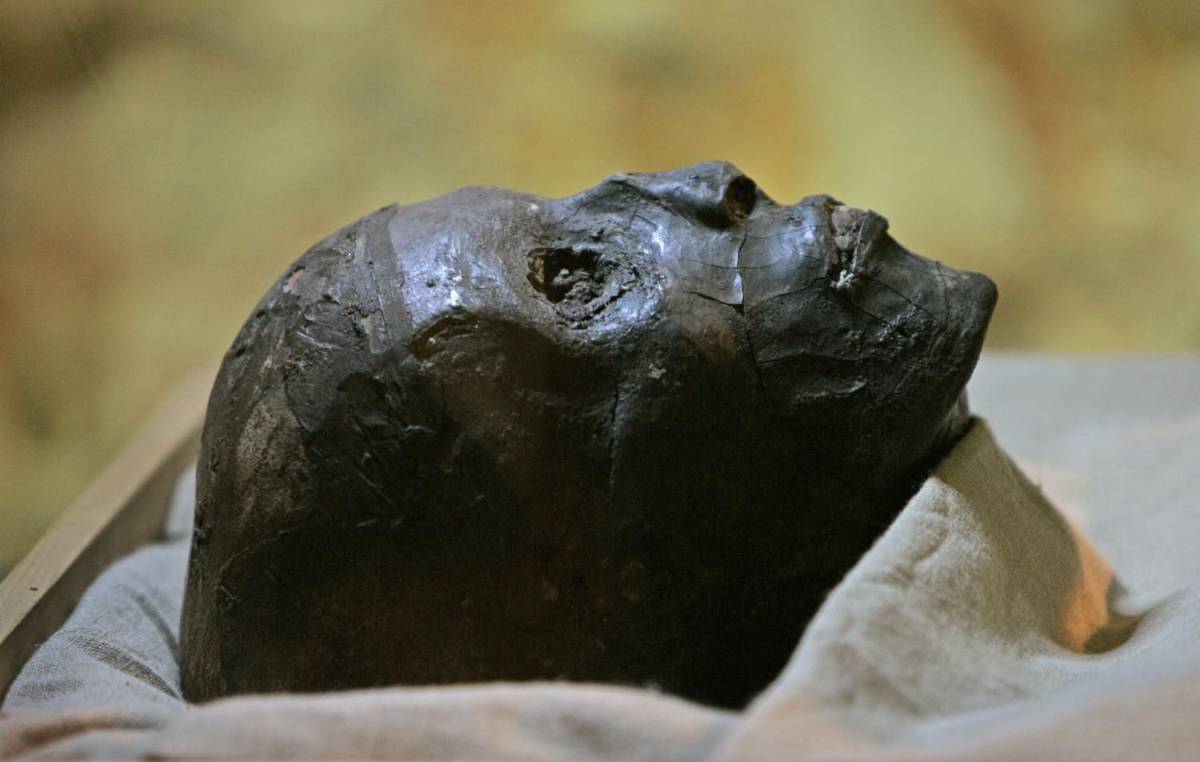
The face of Tutankhamun's mummy / ©Getty Images
The author of the report about the curse of Tutankhamun was one of the Daily Express journalists. The writer Maria Corelli, the author of numerous works on the topic of mysticism, also made her contribution. After the death of Carnarvon, Maria Corelli and Arthur Conan Doyle (also a great lover of mysticism) claimed that they warned the unlucky archaeologists. Even earlier, the British writer Jane Loudon Webb turned to similar topics. Her mystical work “The Mummy” was published back in 1828. Subsequently, authors of fiction will continue to exploit supposedly terrifying warnings. This is how the ominous mystical image of the Egyptian pharaohs was formed in the mass consciousness.
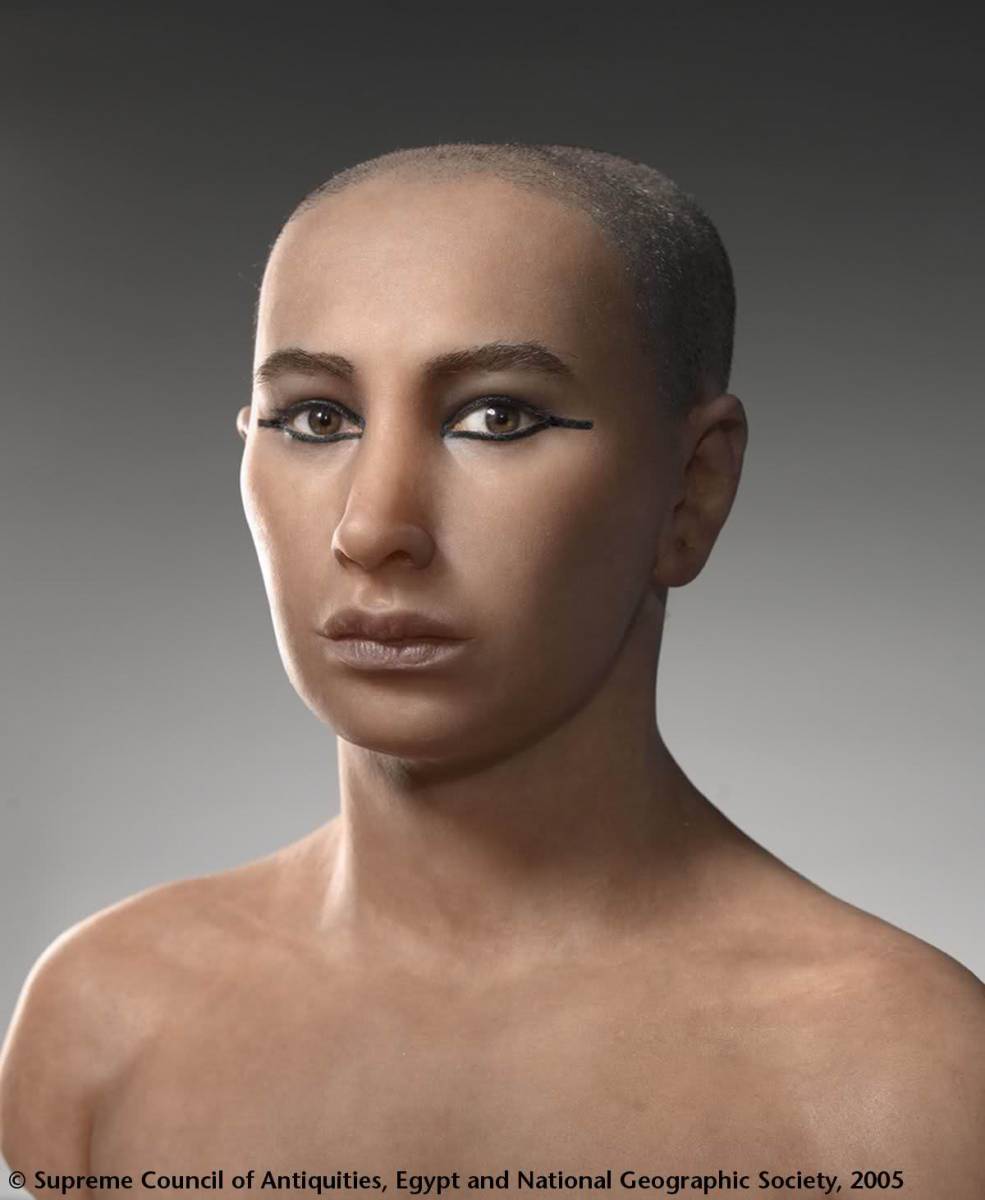
Modeled appearance of Tutankhamun. Recreated by French scientists based on facial reconstruction data made using a computer scan of the pharaoh's mummy / ©National Geographic
“The Curse of Pharaoh Tutankhamun” made the ancient Egyptian theme one of the most popular mystical trends in popular culture. One of the last works of art The science fiction film “Tutankhamun: The Curse of the Tomb”, released in 2006, dealt with this topic.
The Invisible Killer
Despite this, the “curse of the pharaoh” can indeed exist, and it is explained by completely natural factors.
At first, none of the members of Carter's expedition paid attention to the strange plaque on the walls of the tomb. Contrary to the original version of the cracked painting, the cause of the wall stains was fungus. 30 years after a series of mysterious deaths, physician Geoffrey Dean noticed that the symptoms of the disease of the scientists who visited the tomb resembled the so-called “cave disease.” Its cause is microscopic fungi. It is clear that damp and dark rooms, like the tomb of Tutankhamun, became a fertile environment for their spread. Later, the Egyptian biologist Ezzeddine Taha will confirm the validity of this guess, having discovered the fungus in the body of many archaeologists engaged in the study of Ancient Egypt.
In our age, antibiotics reduce the danger of such microorganisms to nothing. But if a person’s immunity is weakened, infection with a fungus can have quite serious consequences. In the 1990s, scientists took a sample of secretions from the lungs of a tourist who died after visiting Tutankhamun's tomb. It was established that the deceased had a fungus in her body, which could have caused her death.
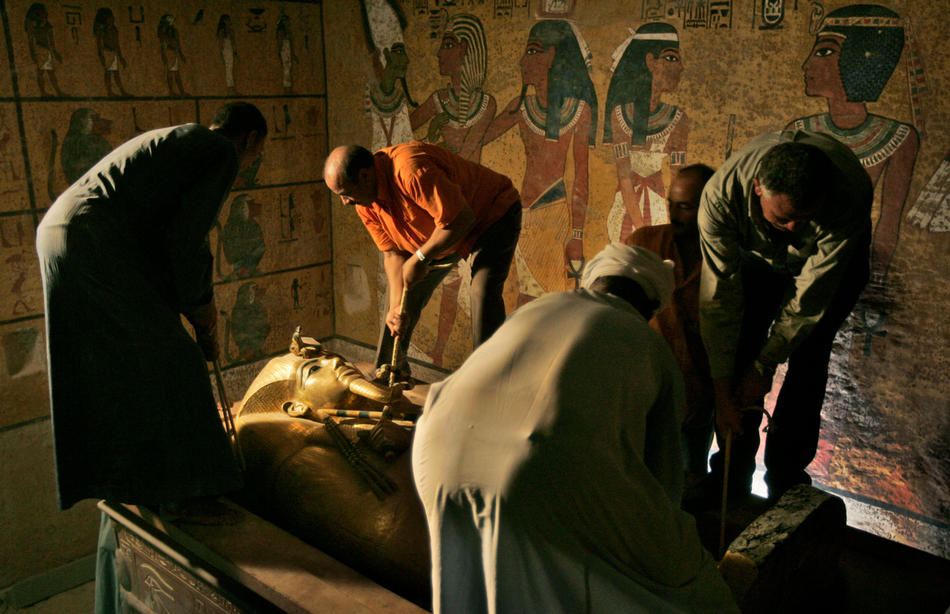
Tutankhamun's sarcophagus is placed back into the underground tomb (Valley of the Pharaohs, November 4, 2007). The mummy of the 19-year-old pharaoh, whose life and death has intrigued people for almost a century, was placed in a special climate-controlled glass box, leaving only his face and legs uncovered / ©Wikimedia Commons
Participants in Carter's expedition could also have become victims of harmful microorganisms that they became infected with while being near the mummy. One important circumstance speaks in favor of this version. After 3,000 years, the oils used for mummification turned into glue. To remove the pharaoh from the coffin, Carter took a decisive step - he cut the mummy. In those years, Egyptologists rarely used special protective equipment, and upon contact with the mummy, harmful microorganisms could easily penetrate the respiratory tract, causing severe illness.
Tutankhamun belonged to the XVIII dynasty of pharaohs - one of the most famous in the history of Ancient Egypt. The time of her reign falls on the era of the New Kingdom. The founder of the dynasty, Ahmose I, united the scattered territories of Egypt, and his descendants ruled the country from 1550-1292 BC. e. Representatives of the dynasty were several powerful rulers who changed the history of their country, as well as a number of female pharaohs.
Modern researchers note that working with a mummy can be dangerous, since the mummified body may contain harmful bacteria. There is also the other side of the issue: bacteria brought in from outside can destroy the mummy.

In our opinion, the version that the cause of death of visitors to Tutankhamun’s tomb was a fungus sounds quite plausible. But there is still no official point of view regarding the series of mysterious deaths. Just as there is no evidence that scientists and ordinary tourists were killed by harmful microorganisms.
Tutankhamun's father Akhenaten was one of the most prominent religious reformers in history. It was he who first introduced monotheism in Egypt, “abolishing” the entire pantheon of Egyptian deities and leaving only the sun god – Aten. Most likely, the purpose of this innovation was to strengthen the personal power of the pharaoh. The reform could also be used to centralize the Egyptian power.
With a request to comment on this issue, we turned to Viktor Solkin, a full member of the International Association of Egyptologists, President of the Association for the Study of Ancient Egypt. He said:
– In fact, only the death of George Herbert Carnarvon, who was a philanthropist of the expedition, can be called sudden and somewhat strange. After being cut off by a mosquito bite while shaving, the lord died of sepsis, after which everything connected with Egypt began to be perceived extremely negatively in his family, and most of his excellent collection was sold in the United States. The remaining deaths are not at all as numerous as they often write about in the press. They were connected, first of all, with the fact that after the discovery of the tomb of the young king, members of the Carter expedition worked tirelessly in the Valley of the Kings, including in the summer months, when the temperature in the Valley sometimes exceeded 50 degrees. Several members of the expedition died - all elderly people who simply had difficulty physically enduring the trials that befell them in the climate and sands of Egypt. Howard Carter himself, seemingly the main culprit in the discovery of the royal tomb, died at an advanced age and from natural causes. Almost 17 years have passed since the opening of the tomb. In addition, in the first third of the 20th century, everything “Egyptian” was still associated with mysticism, spiritualism and other phenomena that accompanied the European “Egyptian delight”. The press and salon society could not resist seeing something otherworldly in several heart attacks of elderly scientists.
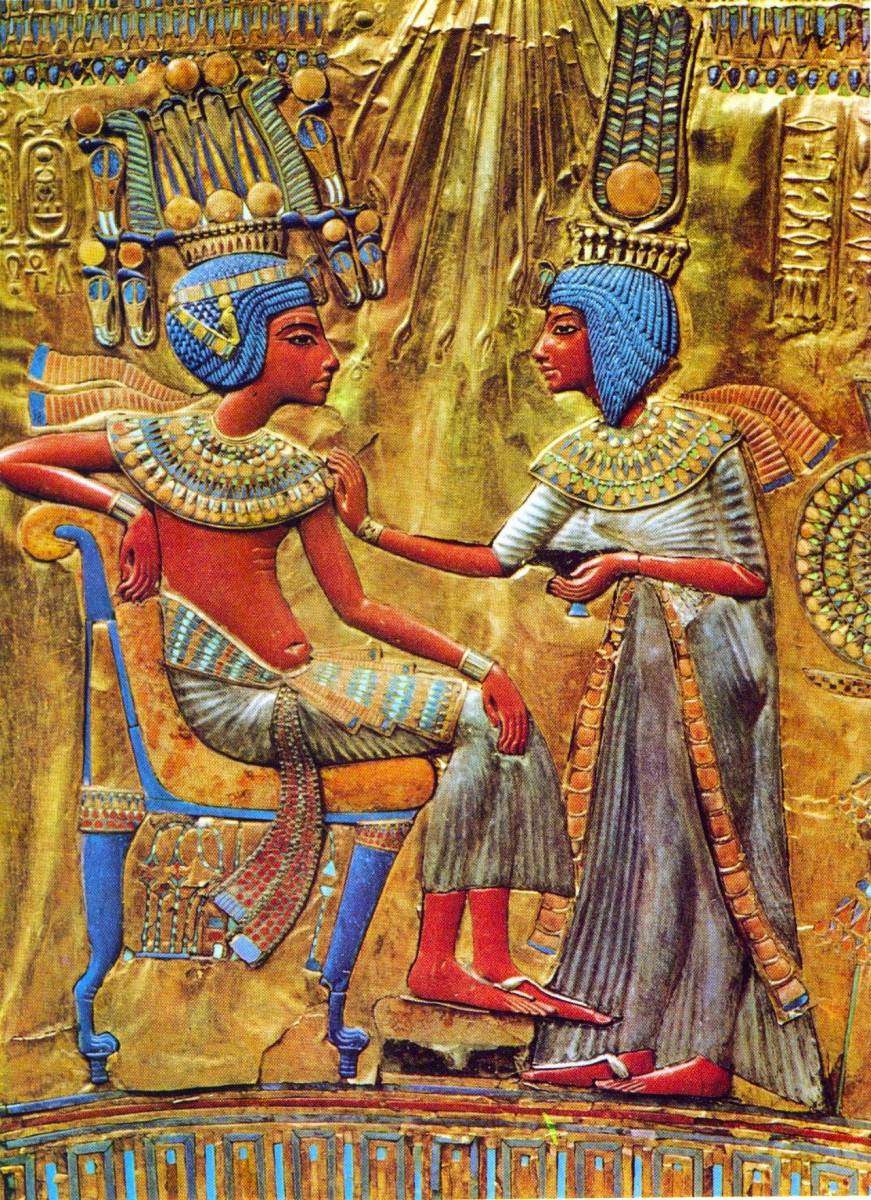
It must be said that in the ancient Egyptian worldview there is no idea at all that a curse on tomb robbers should cause sudden death. Surviving examples of texts directed against those who threaten the deceased, on the contrary, speak of the wrath of the gods in the afterlife. “As for the one who touches this pyramid and this temple with his finger, which belong to me and my Ka (double, life force) - he will be condemned by the nine gods, and he will be in non-existence, and his house will be in non-existence, he will be the one whom condemned, those who devour themselves” - this quote, given on behalf of the king, is found in the famous “Pyramid Texts”, which appeared on the walls of the royal tombs in the 25th century BC. Posthumous retribution, non-existence in the world of the gods was a much more serious punishment in the eyes of the Egyptians than the banal death of the physical body - an important, but not the main component of the essence of man. There were no curse texts at all in Tutankhamun's tomb. The notorious “clay curse tablet” allegedly found by archaeologists, newspaper duck. Its author is well known - archaeologist Arthur Weigall, who disliked Carter and the rumor of a “curse” made the life of an outstanding archaeologist, already besieged by the press, much more difficult. The media did not have enough information, since the London Times received the exclusive right to report from the tomb by decision of Lord Carnarvon.
The wife of Tutankhamun was Queen Ankhesenamun, the daughter of the same Akhenaten. From her, Tutankhamun had two daughters who were stillborn. Most likely, Tutankhamun’s brother was Smenkhkare, another pharaoh from the same dynasty. Smenkhkare ruled immediately after the death of his father until the nine-year-old Tutankhamun came to power.
Our expert:
Victor Solkin, full member of the International Association of Egyptologists, President of the Association for the Study of Ancient Egypt
Almost everyone knows the name Tutankhamun. This is the most famous and famous of the pharaohs of Egypt. And people are especially interested in his burial place, namely the tomb of Tutankhamun. Many legends and disputes are associated with the tomb of Tutankhamun.
There is a legend that anyone who dares to disturb the peace of the pharaoh will die. And during scientific research of the tomb, truly learned archaeologists died. And only through certain studies, scientists established that the death of archaeologists did not occur due to the curse of Tutankhamun’s pyramid. Death occurred due to lack of oxygen. Unlike other pyramids built in the Valley of the Kings, Tutankhamun's pyramid did not have a ventilation system. It is known that archaeologists who explored other pyramids did not die as suddenly as those who explored the pyramid of Tutankhamun.
The pyramid of Tutankhamun itself consisted of several rooms. In the central room stood the sarcophagus of the pharaoh himself. All rooms of Tutankhamun's pyramid were densely filled with various valuables and artifacts. In the premises of the pyramid there were about four chariots shrouded in gold, there was a throne made of gold, on the back of which an image of the young pharaoh’s wife was lined with precious stones. There were vessels made of the most transparent alabaster filled with fragrant ointments. Fried geese and hams were stored in wooden cases - this was the food of the pharaoh in afterlife. There were a lot of chests in the pyramid with precious stones, expensive clothes, shoes, etc. The entrance was guarded by two statues of the king himself. After the scientists opened the doors, they saw a solid wall of gold, decorated with turquoise tiles. It was a sarcophagus that took up almost a room. On one side, the sarcophagus had sealed doors with the seal of the pharaoh himself. The mummy of Tutankhamun itself was in three sarcophagi. The first sarcophagus consisted of gilded wood, the second was also made of gilded wood, but still had a shiny mass interspersed with it, and the third sarcophagus was made of a single piece of gold. Tutankhamun's sarcophagus was about two meters high and weighed about two hundred kilograms of gold. The pharaoh's mummy was wearing a lot of jewelry and decorations. The king's feet were encased in forged sandals.
In general, the discovery of Tutankhamun's pyramid was a great event in the field of archaeology. Only when they discovered the tomb of Tutankhamun did scientists realize with what wealth the pharaohs were buried. The discovery of Tutankhamun's pyramid also gave rise to many stories that arose during the course of research, although scientists said that archaeologists died from lack of ventilation, but not everyone believed it. It was only at the beginning of research that the idea of the “curse of the pharaoh” appeared. Immediately after the opening of the pyramid of Tutankhamun, G. Carter found a sign where it was written that anyone who disturbed the peace of the pharaoh would die suddenly. Even earlier, when they found one of the tombs, there was also a similar inscription and scientists found two bodies, one body was a mummy, and the other was the body of a robber who was killed by a stone that fell on his head when he wanted to plunder the tomb.
They started talking more loudly about the curse of Tutankhamun's pyramid when Carnarvon died on April 5, 1923. Soon, no less strange deaths of Lord Carnarvon's relatives followed. Even the woman who looked after the lord, and the doctor who did the mummy's X-ray, die. In a word, everyone who directly or indirectly had at least some connection to the opening of Tutankhamun’s pyramid died mysteriously. In 1930, only Carter G. remained among the witnesses to the opening of the tomb. Carter himself put forward a not very convincing version of so many mysterious deaths. He believed that all these mysterious deaths, are associated with the discovery of Tutankhamun's pyramid, just an accident.
And this is still far from the only mystery of Tutankhamun’s pyramid. Containers with the image of the god Osiris were also found in the tomb. These containers were filled with Nile sand and seeded with grain. When the grain sprouted, it sprouted from the body of the god Osiris. This means that death gives birth to life. Maybe with this message they wanted to make us understand that nothing disappears without a trace. Many more original items have been discovered even today.
Truly unique things were recovered from Tutankhamun's pyramid. One of these unique things is a stone coffin with traces of sawing, with a stainless steel pharaoh's dagger and two pipes. The dagger was made highest quality alloy - at that time the Egyptians simply could not know this. The cut was made with a circular saw. And the most interesting exhibits were two small pipes made of copper and a silver alloy. One of these little pipes can put thousands of people into a trance at once, while the other can turn off electricity. In 1954, an archaeologist blew a trumpet, and immediately all the electricity in Cairo went out.
PHARAOH TUTANKHAMUN
After Akhenaten, a transition period was introduced in Egypt.
After Akhenaten, Pharaoh ruled Egypt for 2 years. Tutankhamun(Tut-Ankh-Amon or Amon-Ankh-Toth). He was only 18 years old when he became ruler. He was married to one of the daughters of Nefertiti and Akhenaten. Tutankhamun was given the opportunity to rule only for two years. He ruled during the transitional time between Akhenaten and the next ruler. Tutankhamun communicated telepathically with Nefertiti, and in fact she ruled the country during this year. She had to hide.
Ankhesenamun
Ankhesenamun was the 3rd of 6 reliably known daughters of the reformer pharaoh Akhenaten and his “main wife” Nefertiti. She was born in the old capital of the state - Thebes (ancient Egyptian. Ne, Ne-Amon, Uast) in the 5th year of her father's reign. Carrying out religious reform, Akhenaten built a new capital, Akhetaten (modern Tell el-Amarna), where the princess spent her childhood. She probably lived either in the main or in the Northern Palace, which belonged to her mother Queen Nefertiti. The essence of Akhenaten’s transformations was to replace the old gods with the cult of the solar disk of Aten, therefore, like her older sisters, the princess was named after Aten - Ankhesenpaaten. This name meant “She lives thanks to Aten.”
Born before the completion of the capital, Ankhesenpaaton appears on many Amarna reliefs and bears the traditional title for a princess: “The daughter of the king from his flesh, beloved by him, Ankhesenpaaton, born of the great wife of the king, his beloved Nefer-neferu-Aten-Nefertiti, she lives forever, forever (ancient Egyptian nsw-sn.t h.t-f mr.t-f ˁnḫ-s-n-itn-rˁ ms-n nsw-tḫm.t-wr.t mr.t-f nfr-nfr.w-itn-nfr. t-jty ˁnḫ-ti ḏt-nḫḫ)".
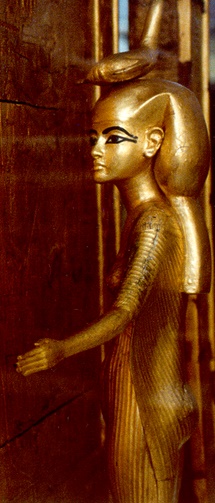
Ankhesenamun in the image of the goddess Serket. (Gilded statue of one of the 4 guardian goddesses from the tomb of Tutankhamun, XIV century BC)
On the monuments of the last years of Akhenaten’s reign, Princess Ankhesenpaaton appears with a girl named Ankhesenpaaton-Tasherit in her arms. The inscriptions say that this is the child of the pharaoh.
Apparently the princess was betrothed to Tutankhamun while her father was still alive in Akhetaten.
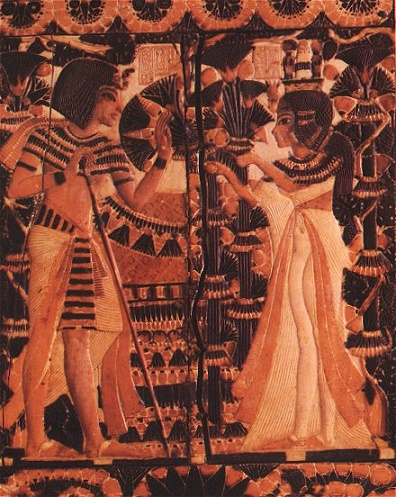
Tutankhamun receives flowers from Ankhesenpaaton. Fragment of a wooden chest 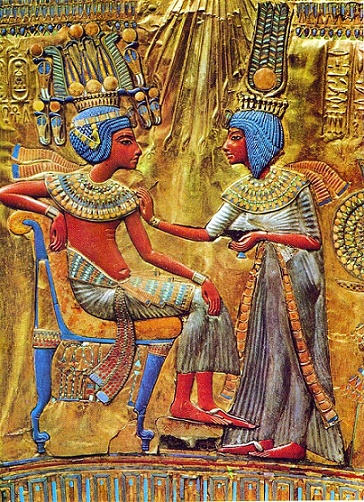
Tutankhamun and Ankhesenamun. Fragment of the back of the golden throne of Tutankhamun, XIV century. BC.
Aya appears again in documents as a mentor to the young reigning couple.
Ankhesenamun did not give birth to heirs to Tutankhamun and after the death of the latter she became a dowager ruler. The death of her husband was a real tragedy for the queen. A symbol of her love for her husband can be a wreath of flowers left on the sarcophagus of the young pharaoh. This bouquet was preserved for 3,300 years and was discovered by archaeologist Howard Carter when opening the tomb of Tutankhamun.
Treasures of Tutankhamun's tomb
The English Lord Carnarvon - heir to a huge fortune, collector and sportsman - was also one of the first motorists. He barely survived one of the car accidents, and since then he had to give up his dreams of sports. To improve his health, the bored lord visited Egypt and there became interested in the great past of this country. For his own entertainment, he decided to take up excavations himself, but his independent attempts in this field turned out to be fruitless. Money alone was not enough for such a task, and Lord Carnarvon did not have enough knowledge and experience. He was recommended to seek help from Howard Carter, who came to archeology in a completely different way.
In 1914, Lord Carnarvon saw the name of Tutankhamun on one of the earthenware cups found during excavations in the Valley of the Kings. The same name was on the gold plate from the small cache. These finds forced the lord to obtain permission from the Egyptian government to search for the tomb of the pharaoh. The same material evidence also supported G. Carter when he was overcome by despondency from a long but fruitless search. But first, members of Lord Carnarvon's expedition decided to clear the Valley of the Kings from piles of sand. They laid rails, and trolleys rolled along this narrow-gauge railway, transporting sand and rubble, ton after ton. Archaeologists searched for the tomb of Pharaoh Tutankhamun for seven long years, but in the end happiness smiled on them.
Sensational news spread around the world in the beginning. 1923 In those days, crowds of reporters, photographers and radio commentators flocked to the small and usually quiet Egyptian town of Luxor. From the Valley of the Kings, reports, messages, notes, essays, reports, reports, articles were rushing hourly by telephone and telegraph...
For eighty-four days, archaeologists reached the inner golden coffin of Tutankhamun - through four outer arks, a stone sarcophagus and three inner coffins - until they finally saw the one who for a long time was only a ghostly name for historians. But first, archaeologists and workers discovered steps that led deeper into the rock and ended at the walled-up entrance. When the entrance was cleared, behind it there was a corridor covered with fragments of limestone, and at the end of the corridor there was another entrance, which also turned out to be walled up.
Having made a hole in the masonry, Howard Carter stuck his hand in with a candle and clung to the hole. “At first I didn’t see anything,” he later wrote in his book. - Warm air rushed out of the room, and the candle flame began to flicker. But gradually, when the eyes became accustomed to the twilight, the details of the room began to slowly emerge from the darkness. There were strange figures of animals, statues and gold - gold shimmered everywhere!
When Lord Carnarvon and G. Carter entered the first room, they were stunned by the number and variety of objects that filled it. There were chariots covered in gold, bows, a quiver of arrows and shooting gloves; beds, also upholstered in gold; armchairs covered with the smallest inserts of ivory, gold, silver and gems; magnificent stone vessels, richly decorated caskets with clothes and jewelry.

The first room was followed by others, and what was discovered in the tomb of the pharaoh exceeded the wildest expectations of the expedition members. Here were magnificent works ancient Egyptian art. Ruthless time destroys many things, in addition, thieves also visited the tomb in ancient times. Countless treasures, which were supplied to the deceased rulers, members of their families and important dignitaries, have long attracted greedy robbers. Neither terrible spells, nor careful security, nor pyramid mountains, nor clever tricks of architects (camouflaged traps, walled chambers, false passages, secret staircases, etc.) helped against them. But thanks to a happy coincidence, the tomb of Pharaoh Tutankhamun remains the only one preserved almost completely intact.
The fact that G. Carter's expedition discovered the tomb was in itself an incomparable success. But fate smiled at him one more time, and in those days he wrote: “We saw something that not a single person of our time was awarded.”
From the front chamber of the tomb alone, the English expedition removed 34 containers full of priceless jewelry, precious stones, gold and works of art. And when the members of the expedition entered the funeral chambers of the pharaoh, they found a wooden gilded ark, and in it another - an oak ark, in the second - a third gilded ark, and then a fourth. This fourth contained a sarcophagus made from a single piece of the rarest crystalline quartzite, and there were two more sarcophagi in it. Now the treasures from Tutankhamun's tomb are on display in Egyptian Museum in Cairo and occupy ten halls there, the area of which is equal to a football field.
Tutankhamun had two statues of Ka, which were carried in a row of honor in the funeral procession - immediately after the pharaoh's sarcophagus. In the burial chambers, these statues stood on the sides of the sealed door leading to the golden sarcophagus. Ka is the life force that the gods endow every mortal at birth. This force was invisible, but was depicted in the guise of the one it inspired. With the death of a person, Ka left his body, but still took care of her master. The well-being of Ka, in turn, depended on the condition of the body of the deceased, which is why embalming was given such importance in Ancient Egypt.
Ka Pharaoh has a youthfully handsome face with wide-set eyes looking with the dispassionate stillness of death. Ancient sculptors and artists repeated it many times on chests, chests and arks. The dimensions of the statue of the spirit-double helped scientists determine the height of the pharaoh himself, since according to ancient Egyptian tradition the dimensions corresponded to the height of the deceased. It turned out that the height of Ka and the data obtained from examining Tutankhamun’s body differ by only a few millimeters.
The human soul is Ba, and it was represented in the form of a bird with a human face. The ba of Tutankhamun was guarded by a wooden sculpture depicting the pharaoh on the funeral bed, and on the other side a falcon overshadowed the sacred mummy with its wing. Ba and the falcon represent heavenly protection. On the figurine of Tutankhamun, archaeologists saw carved words with which he addressed the sky goddess in prayer: “Come down, Mother Nut, bend over me and turn me into one of the immortal stars that are all in you!” This sculpture was among the gifts that friends and courtiers presented to the now dead pharaoh, as an obligation to serve him in the afterlife.
To get to the sacred mummy of Tutankhamun, scientists had to open several sarcophagi. “The mummy lay in a coffin,” writes G. Carter, “to which she was tightly stuck, since, having been lowered into the coffin, she was filled with aromatic resins. The head and shoulders, right down to the chest, were covered with a beautiful golden mask, reproducing the features of the royal face, with a headband and necklace. It was impossible to remove it, since it, too, was stuck to the coffin with a layer of resin, which thickened into a mass as hard as stone.” The head was apparently shaved bald, and its skin was coated with some kind of whitish compound (probably a known type of fatty acid).
The third coffin, in which the mummy of Tutankhamun lay (the king is depicted in the image of Osiris), was entirely made of massive gold sheet with a thickness of 2.5 to 3.5 millimeters. In its shape, the third coffin repeated the previous two (the first was made of gilded wood, the second was entirely inlaid with multi-colored glass), but its decor was more complex. The pharaoh's body was protected by the wings of the goddesses Isis and Nephthys; chest and shoulders - kite and cobra - patron goddesses of the North and South. They were placed on top of a golden coffin, with each kite feather filled with pieces of gems or colored glass.
The mummy lying in the third coffin was wrapped in many shrouds. On the top veil were sewn golden hands holding a whip and a staff; under them there was also a golden image of the soul in the form of a bird with a human head. At the places of the belts there were longitudinal and transverse gold stripes with the texts of prayers.
When Howard Carter unwrapped the mummy from the shrouds, he found many more precious jewelry, the inventory of which is divided into 101 groups. For example, on the body of the king, scientists found two daggers - bronze and silver. The handle of one dagger is decorated with gold grain and framed with interlocking ribbons of cloisonné enamel. At the bottom, the decorations end with a chain of scrolls made of gold wire and a rope design. The blade, made of hardened gold, has two more longitudinal grooves in the middle, topped with a palmette, above which there is a geometric pattern in a narrow frieze. The forged gold mask that covered Tutankhamun's head was made of a thick sheet of gold and richly decorated: the stripes of the scarf, eyebrows and eyelids were made of dark blue glass, the wide necklace shone with numerous inserts of gems. Tutankhamun's golden throne was made of wood, covered with gold leaf and richly decorated with inlays of multi-colored faience, glass and stones. The legs of the throne in the shape of lion paws are topped with lion heads made of beaten gold; the handles represent winged snakes coiled in a ring, supporting the pharaoh's cartouches with their wings. Between the supports behind the back of the throne there are six uraei with crowns and solar disks. They are all made of gilded wood with inlay: the heads of the uraei are of purple faience, the crowns are of gold and silver, and the sun discs are of gilded wood.
On the back of the throne there is a relief image of papyrus and water birds. On the front back there is a one-of-a-kind inlaid image of the pharaoh and his wife. The lost gold decorations that connected the seat with the lower frame are an ornament of lotuses and papyrus, united by a central image - the hieroglyph “sema”, which symbolized the unity of Upper and Lower Egypt. In Egypt, from time immemorial, there was a custom of decorating the bodies of the deceased with wreaths of flowers. The wreaths found in the tomb of Tutankhamun, of course, did not reach us in very good condition; two or three flowers crumbled into powder at the first touch. The leaves turned out to be very brittle, and scientists kept them in lukewarm water for several hours before starting their research.
The necklace found on the lid of the third coffin was composed of leaves, flowers, berries and fruits of various plants mixed with blue glass beads. All this was arranged in nine rows, tied to semicircular strips cut from the core of papyrus. By analyzing flowers and fruits, scientists were able to establish the time of the pharaoh’s burial - it happened between mid-March and the end of April. It was then that cornflowers bloomed in Egypt, and the fruits of mandrake and nightshade, woven into a wreath, ripened.
In magnificent stone vessels, archaeologists found fragrant ointments with which Tutankhamun was supposed to anoint himself in the afterlife, just as he did during life. These perfumes, even after 3000 years, emitted a strong aroma...
Two mummified human embryos were found in Tutankhamun's tomb. It is believed that these are the premature daughters of the royal couple.
For the tomb of a pharaoh, the grave looked very hastily made. The fact that it was not originally intended for a royal person was indicated not only by its modest size, but also by its sloppy decoration: there were stains of paint on the wall paintings that no one bothered to erase. Some items of utensils that so amazed the world with their sophistication, in fact, apparently were taken from a funeral warehouse, since upon careful examination they were found to contain traces of inscriptions of the names of other people. These names were erased, and in their place they put the necessary inscription - Tutankhamun. After embalming, whole buckets of balm were poured onto the mummy, which only worsened her condition. Was this part of a ritual or simply an attempt to cover up the crime? To answer this question, in 1925 Carter conducted an anatomical examination of the corpse, which was done with crude methods and was more reminiscent of cutting up a meat carcass. The balm glued the bandages that wrapped the mummy together, so the body was damaged when removed from the sarcophagus. After examining the body, the first anatomist found nothing suspicious. However, more than forty years later, in 1968, a scientist from the University of Liverpool received permission to x-ray the mummy and discovered several intriguing things: a narrow fragment of bone in the brain cavity and some kind of lump at the base of the skull, which could well be a blood clot. Such a clot could have formed as a result of a severe, possibly fatal blow to the back of the head. To find out, Cooper and King took the original X-rays and showed them to medical experts, radiologists and neurologists. Experts immediately discovered new Interesting Facts. For example, the thinned right temporal bone of Tutankhamun, covered with small cracks, which may have appeared when struck by a heavy object. In addition, Tutankhamun suffered from the so-called Klippel-Feil syndrome: he had fused cervical vertebrae. People with this pathology cannot turn their head without turning their entire body. Such an illness cannot be hidden, and it makes a person extremely vulnerable at the moment of a fall or push.
On one of the gifts in Tutankhamun's tomb the name Maya (was treasurer) is inscribed.
During the reign of Akhenaten, Aya bore the high titles of “bearer of the fan at the right hand of the king, chief of the king’s friends,” “chief of all the horses of the ruler of both lands,” “personal scribe of the king.” Aya was a zealous supporter of Akhenaten and the cult of Aten promoted by the latter.
IN last years Akhenaten's reign, the name of Aya is not mentioned. But under Tutankhamun, he is again found in the position of the supreme dignitary - chati (vizier), who under the pharaoh concentrated all real power in his hands.
After the death of Tutankhamun, his widow Ankhesenamun, trying to maintain her rights to the throne, asked the Hittite king Suppiluliuma I to send her one of his sons as a husband. The Hittite king yielded to Ankhesenamon's requests and sent her his son Tsannantsu as her husband. But the prince was killed along the way, perhaps on the orders of the commander Horemheb, who cherished far-reaching hopes that he was not able to immediately realize. It must be assumed that Aya, who was then the vizier of Southern Egypt, knew about the correspondence between Ankhesenamun and Suppiluliuma. Moreover, perhaps it was carried out on his initiative, since by marrying a young widow to a foreigner who knew neither local customs nor orders, he could have retained actual power for a long time. An attempt at rapprochement with the Hittites, apparently undertaken on the initiative of Aya, failed. Suppiluliuma, enraged by the death of his son, invaded the Egyptian territory. In Syria, in the Amka region (south of Kadesh), Egyptian and Hittite troops met, but a decisive battle did not take place, since plague broke out in the Hittite army from Egyptian prisoners. The Hittites were forced to retreat.
The disease claimed the lives of so many of the subjects of King Suppi-lulium I that he was no longer able to wage war as energetically as before in the last years of his reign.
The possibility cannot be ruled out that it was Horemheb who had to lead the reflection of the Hittites. This, naturally, to some extent, distracted him from direct participation in the struggle for Tutankhamun’s legacy. As a result, Aya came to power.
In 1322 BC. The ancient Egyptian solar cycle of 1460 years ended.
Aya and Taya
After Tutankhamun, the Limurians were allowed to rule the country Ayu And Taye. Aya was married to Tayi, the nurse of Pharaoh Akhenaten. Taya was called in the inscriptions “high nurse”, “mother who fed the divine”, “clothing the king”. Taya in official inscriptions was called “the nurse of Nefertiti, the great wife of the king.”
They ruled the country for about 30 years (1335 - 1302 BC).
Wall paintings in Tutankhamun's tomb depict Aya performing the Opening of the Gates ritual at the pharaoh's funeral, a ceremony that would have been performed by the heir to the throne.
The place of residence of Pharaoh Ai, according to the scanty data available, remained Memphis. Aya pretended to resurrect the fighting traditions of warrior kings. Under him, the permanent pharaonic title once again sounded militant, which was not observed in the previous reigns. However, apart from the name “mighty in strength, suppressing the northeast” and the image in the form of a formidable archer on a chariot, there seems to be no news about the military exploits of the elderly pharaoh.
Aya completed the decoration of the temple at Sulba in Nubia, begun under Tutankhamun, where two magnificent sculptures of a lion made of pink granite were installed.
Many records dated to the 3rd year of Ai’s reign have been preserved (in particular, on the slab of the Theban nomarch Ramose). The latest year of Aye's reign known to us is the 4th.
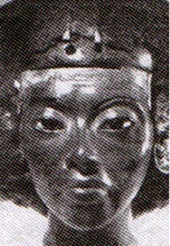
Taya 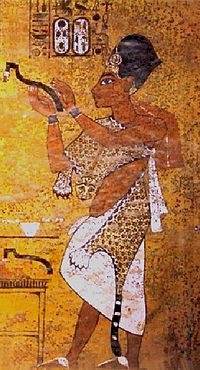
And I
There is an ancient round building in Egypt. For a long time, this was the home of Aya and Taiya. There is a wall in the middle of this round house. To go from one part of the house to another, you need to go outside, go around the house and enter it from the other side. On one side in the middle there are images of Ay, who looks like a typical Egyptian with characteristic clothing, a beard and other Egyptian attributes. He appears to be of normal height. On the other side of the wall, Ai is depicted at 4.8 m tall. He looks completely different, but with the same face and a huge, drawn-back skull.
Ai could transform from one level of Consciousness to another, i.e. he could take on the appearance of an ordinary Egyptian and the appearance of a Limurian/Sirian.
